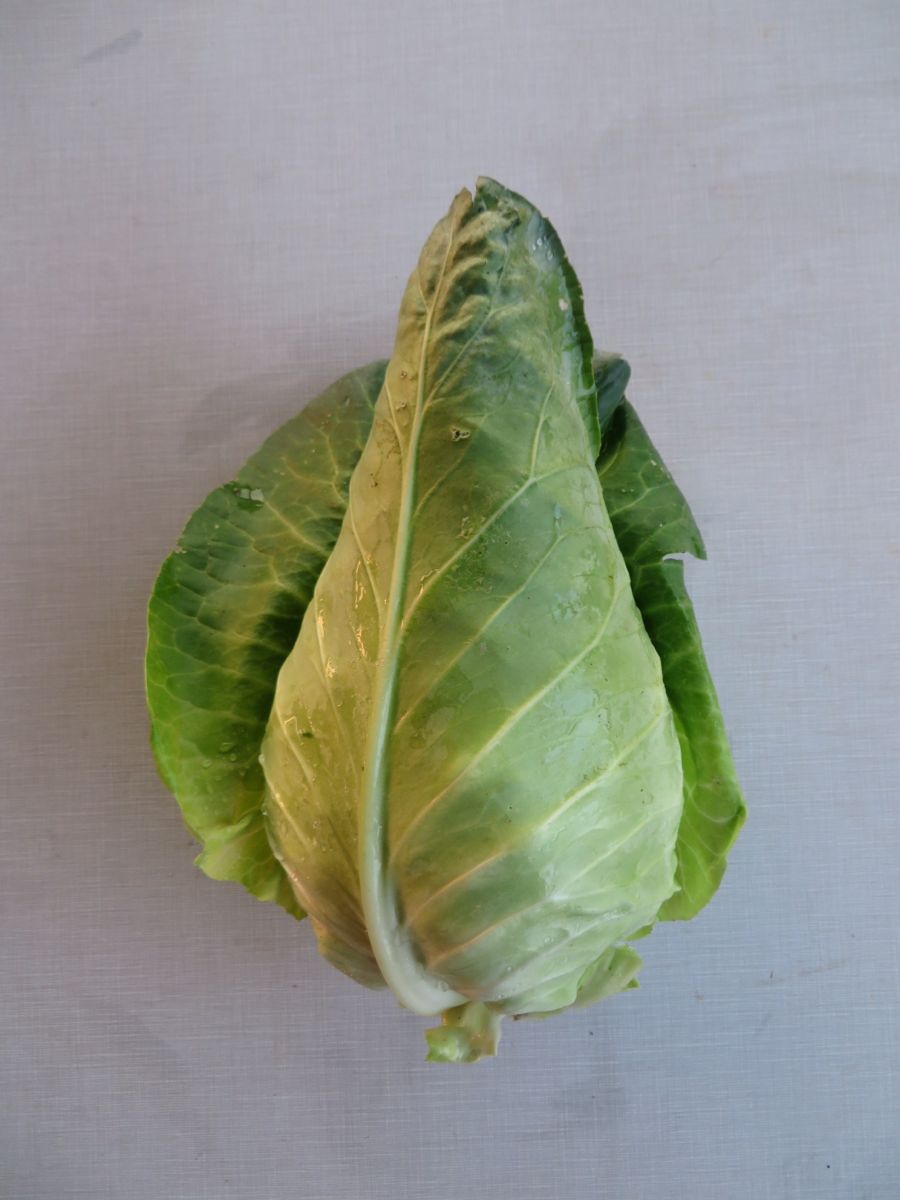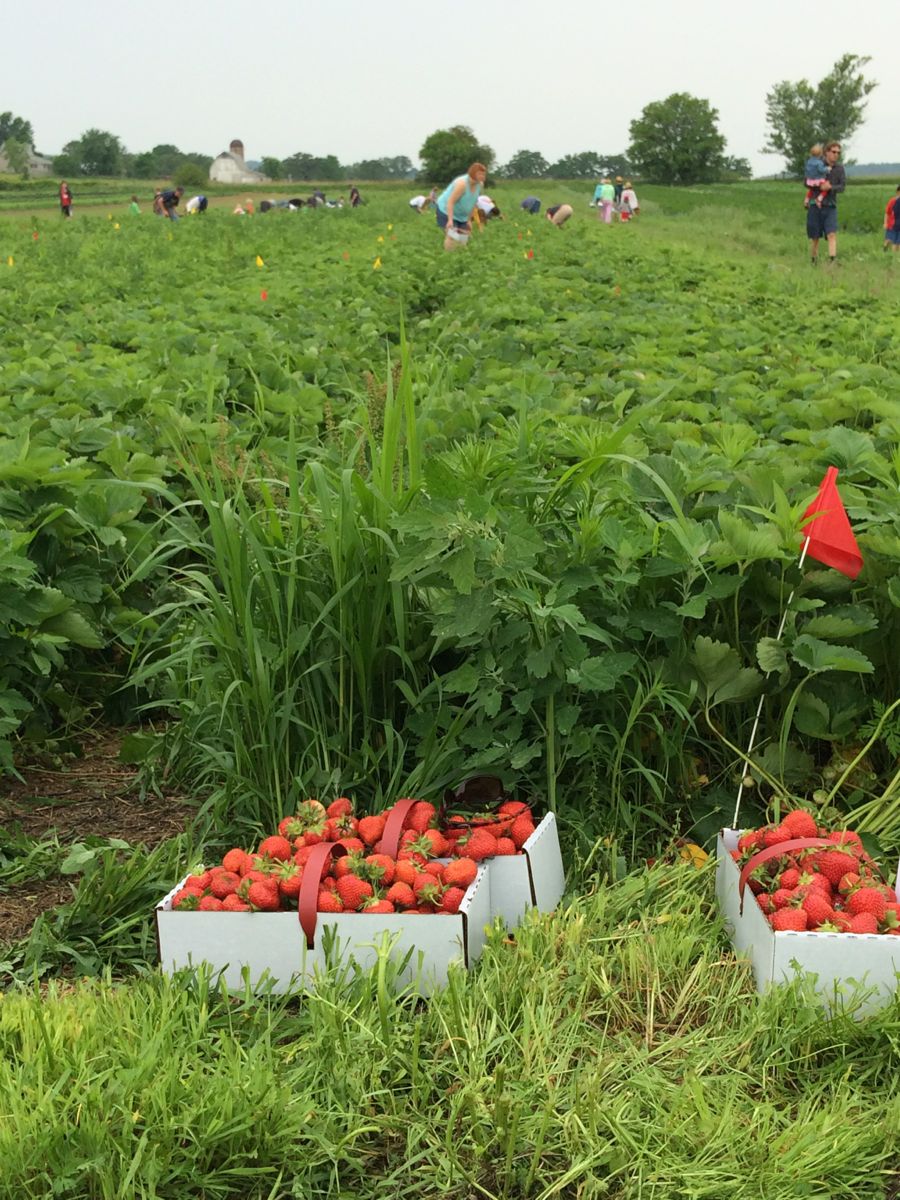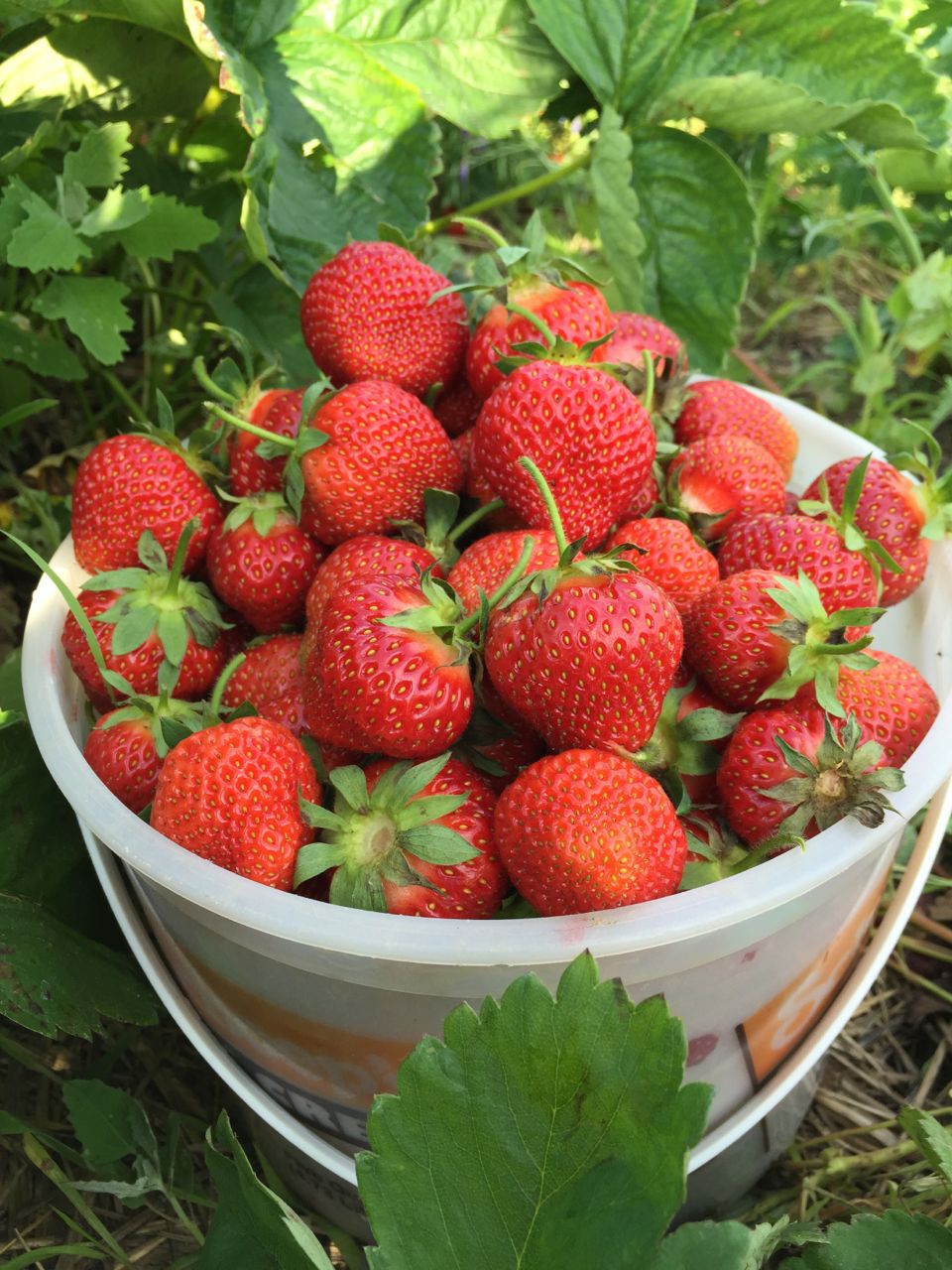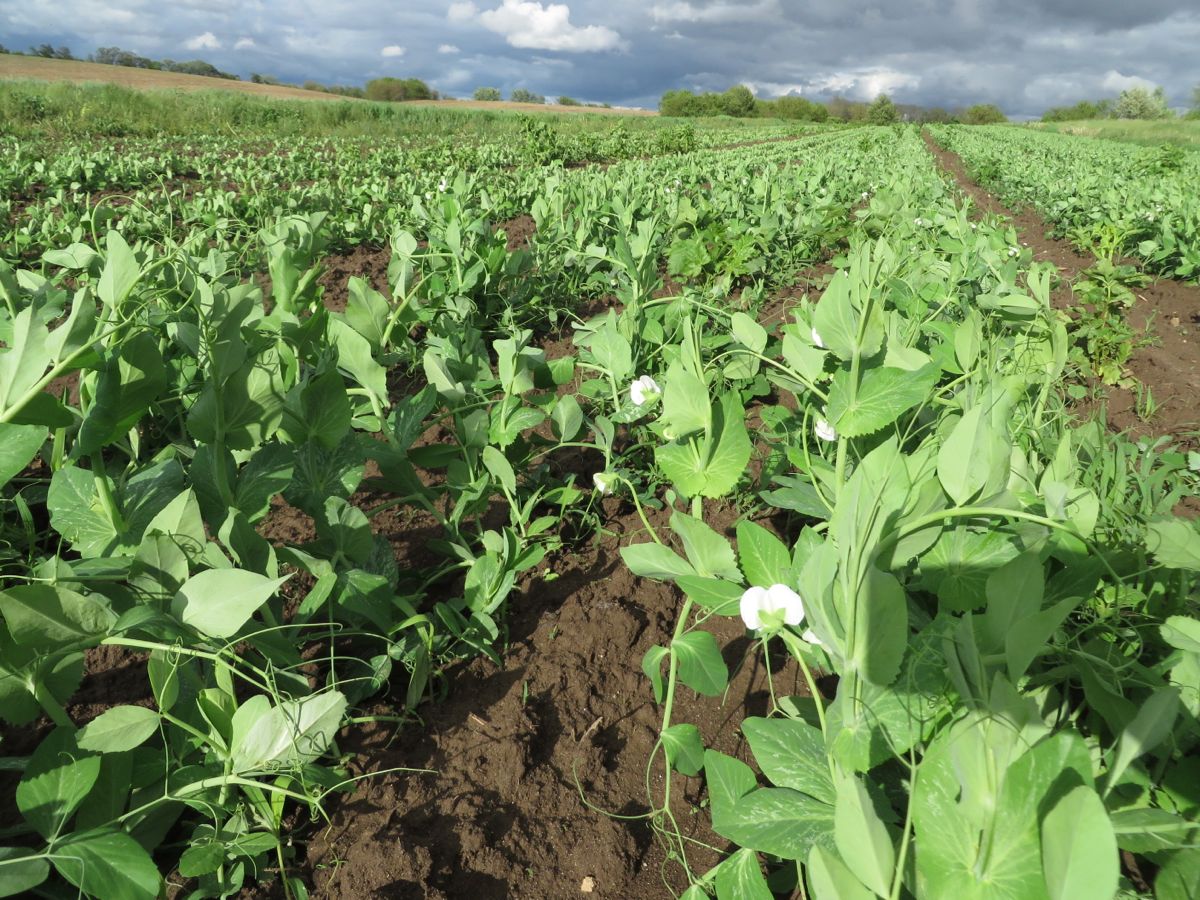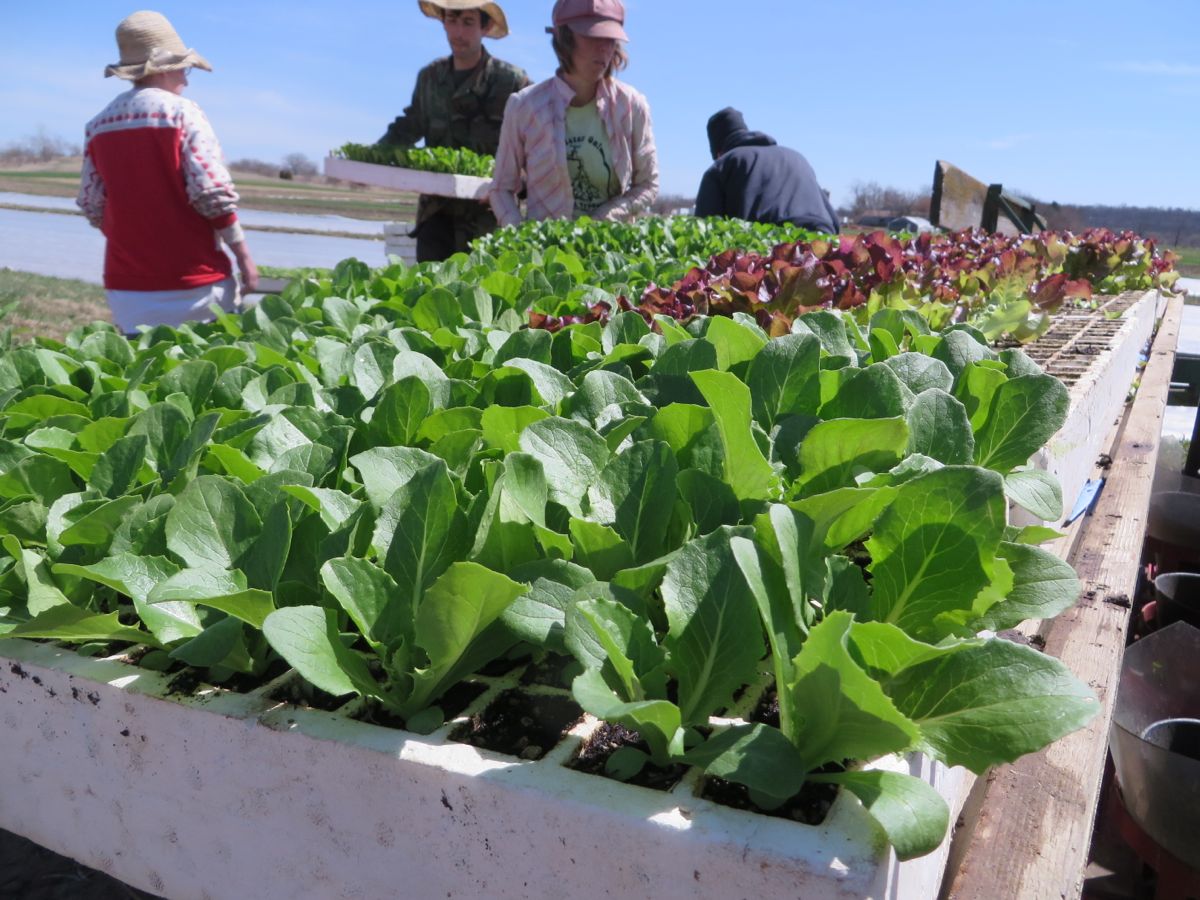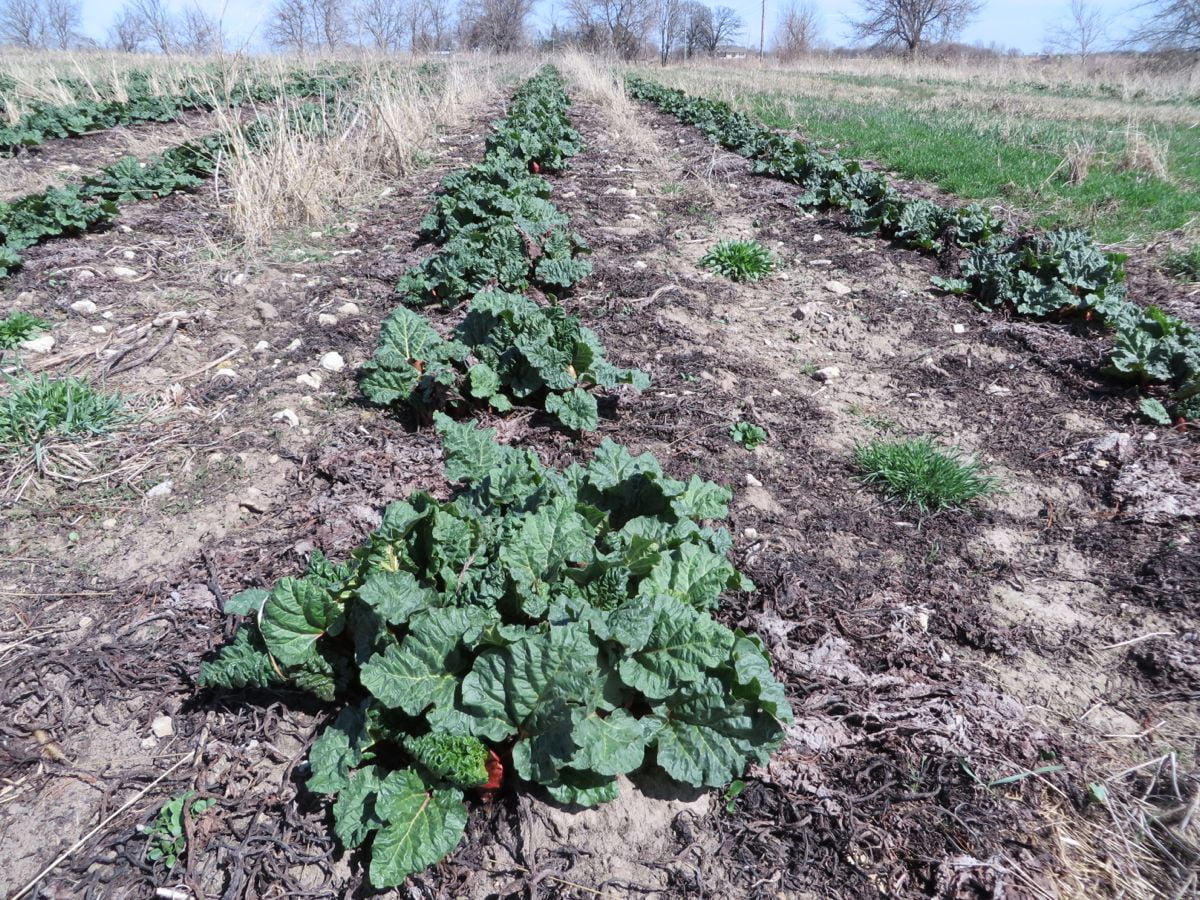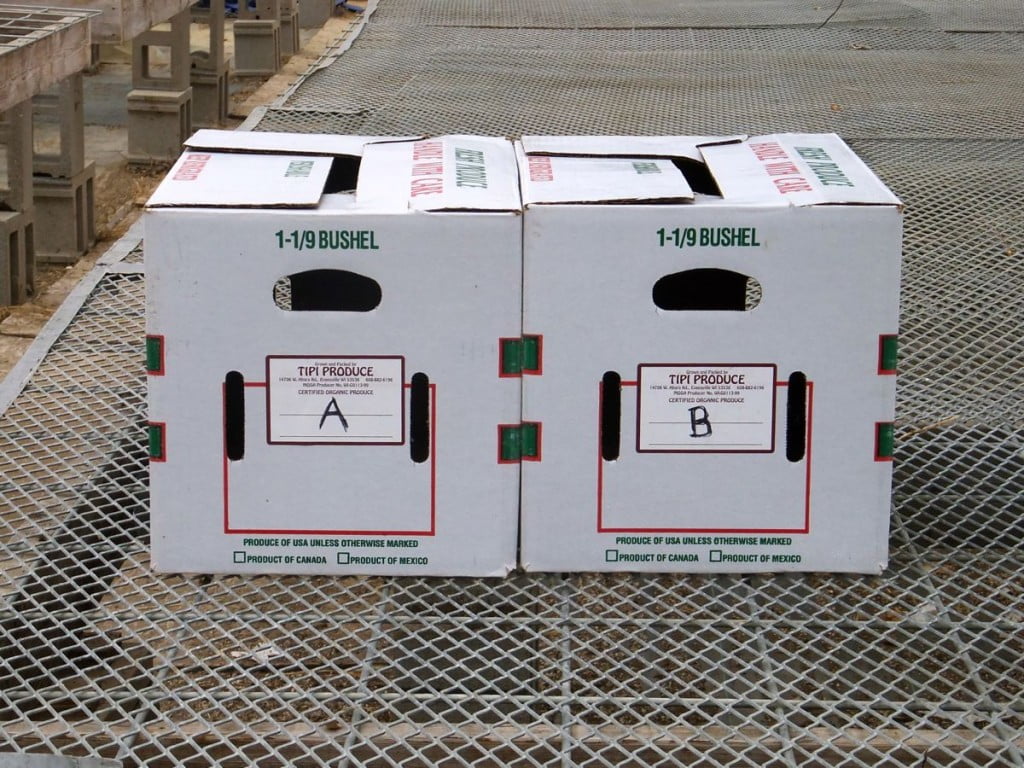Blog
Newest farm hobby
- On: July 01, 2015
 0
0
Maggie and Jon suggested I share the latest farm hobby: collecting interesting bugs. Farmhand Madeleine Wieder is especially taken with the beautiful swallowtail caterpillars. She’s taken two of them home to pupate in a jar, with names “Lewis” and “Carroll.” We find swallowtail caterpillars scattered about the farm on plants in the carrot family (carrots, fennel, dill, parsnip, parsley). Their populations are low so they cause little cumulative damage to our crops. We appreciate the beauty and interest they add to our lives. Check out Wisconsin Butterflies for gorgeous photos and basic bios of species found in Wisconsin. These are probably black swallowtails. I’ll post more photos once they pupate and emerge as butterflies.
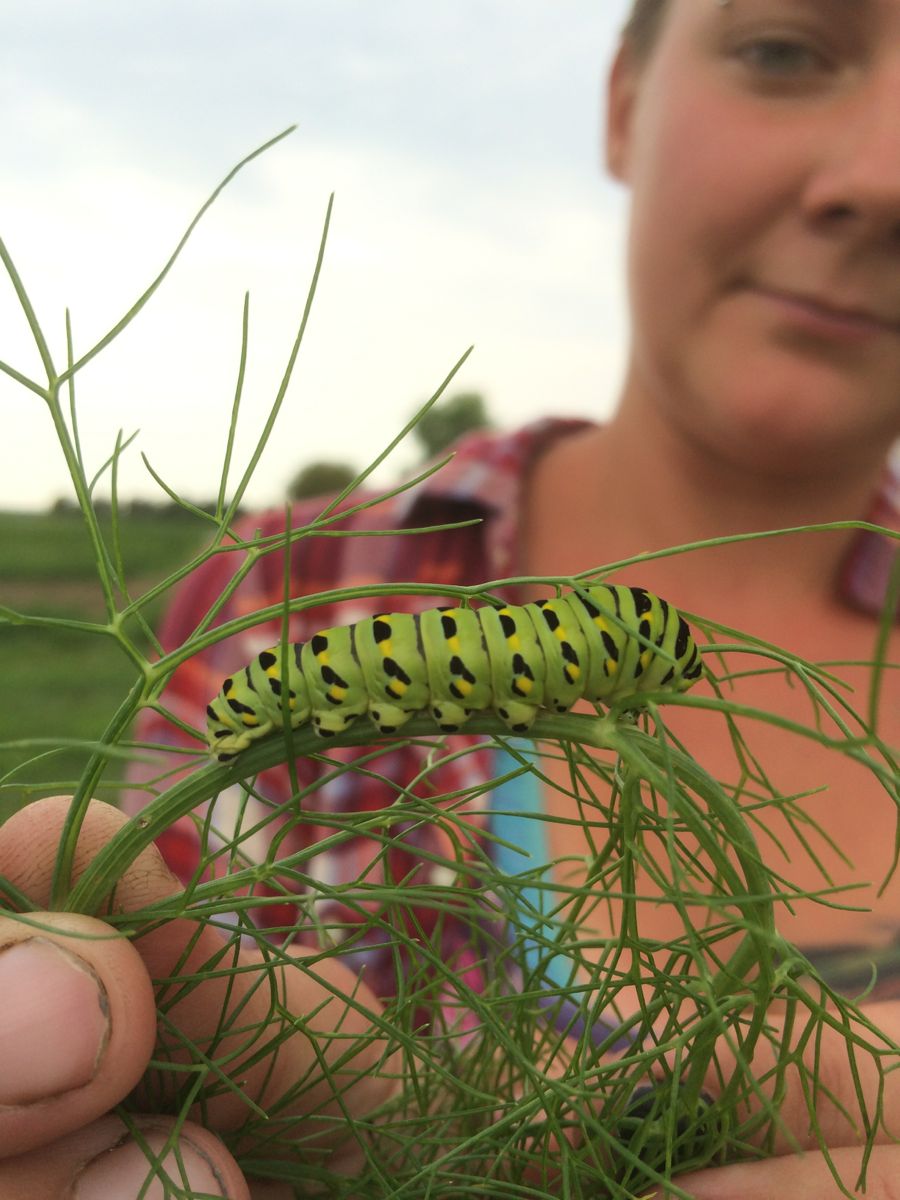
Madeleine holds a swallowtail caterpillar on a fennel frond.
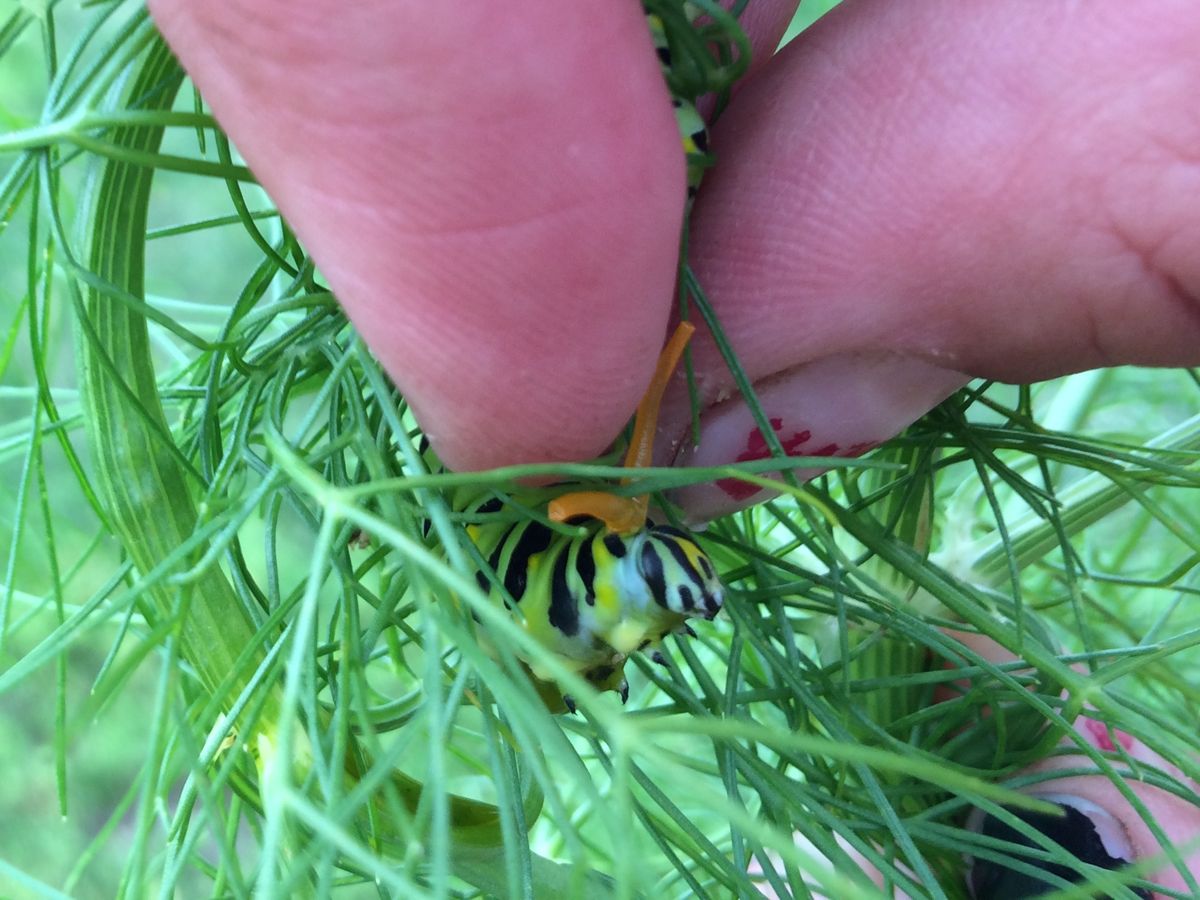
When threatened, the caterpillars unfurl bright orange ‘horns’ and release an incredible stench. Trust us, they really do stink.
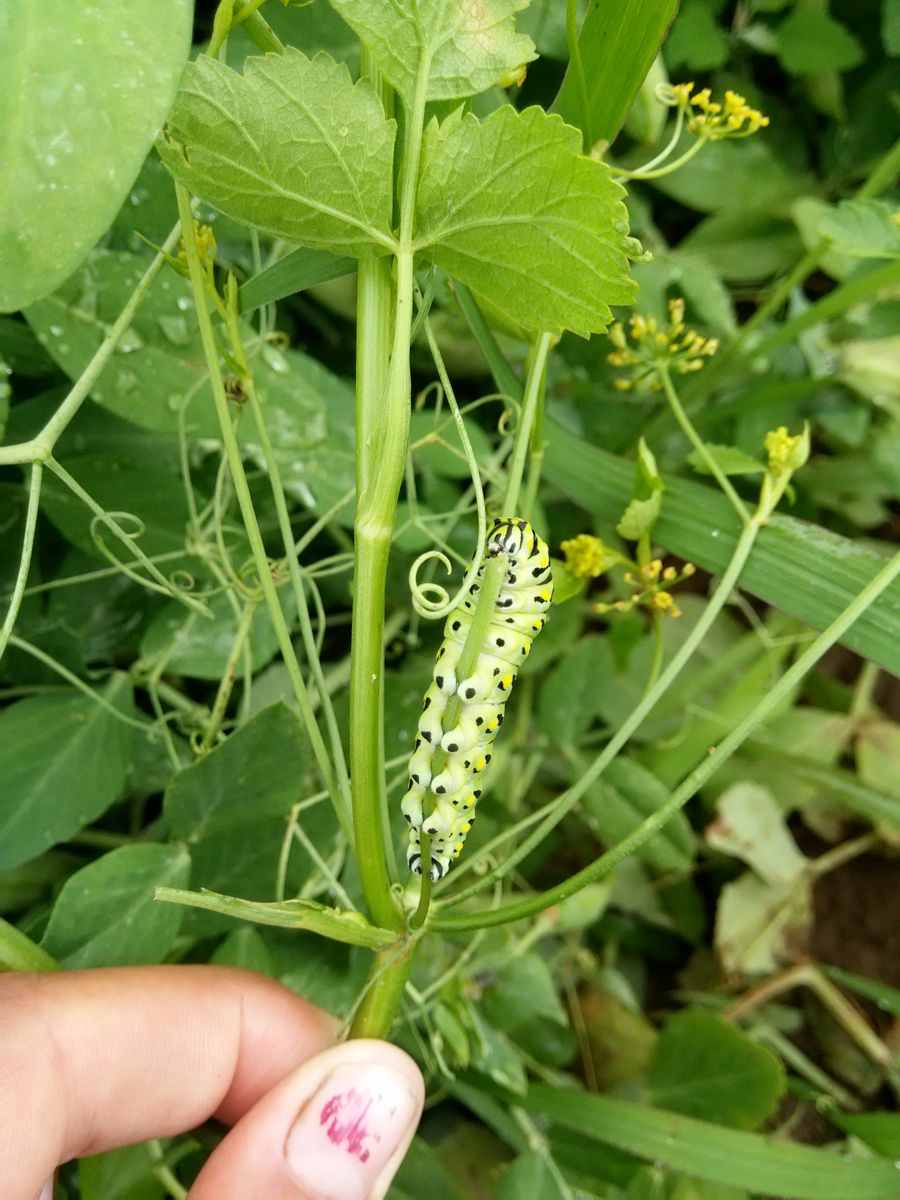
Madeleine has found swallowtails on parsnips growing in our pea field, …
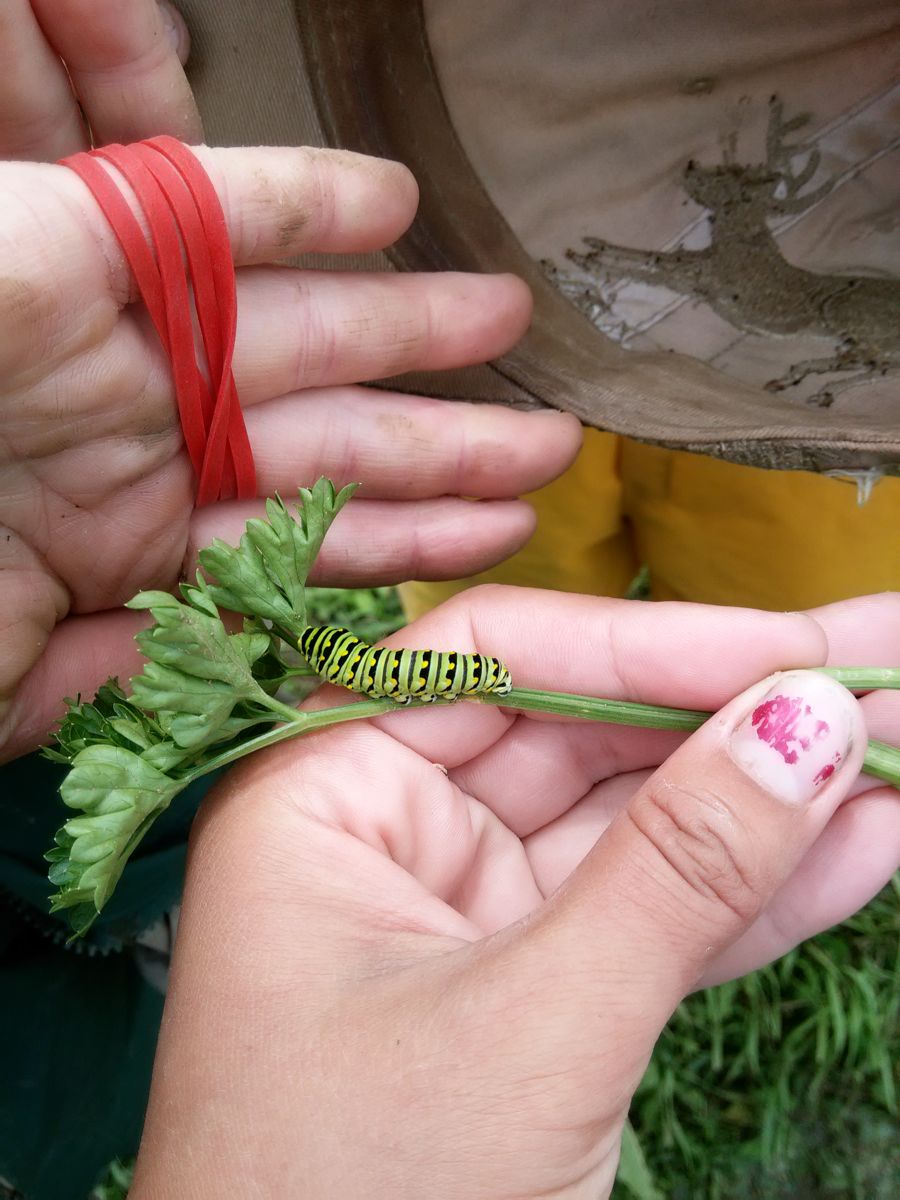
… while bunching parsley (hence the rubber bands), …
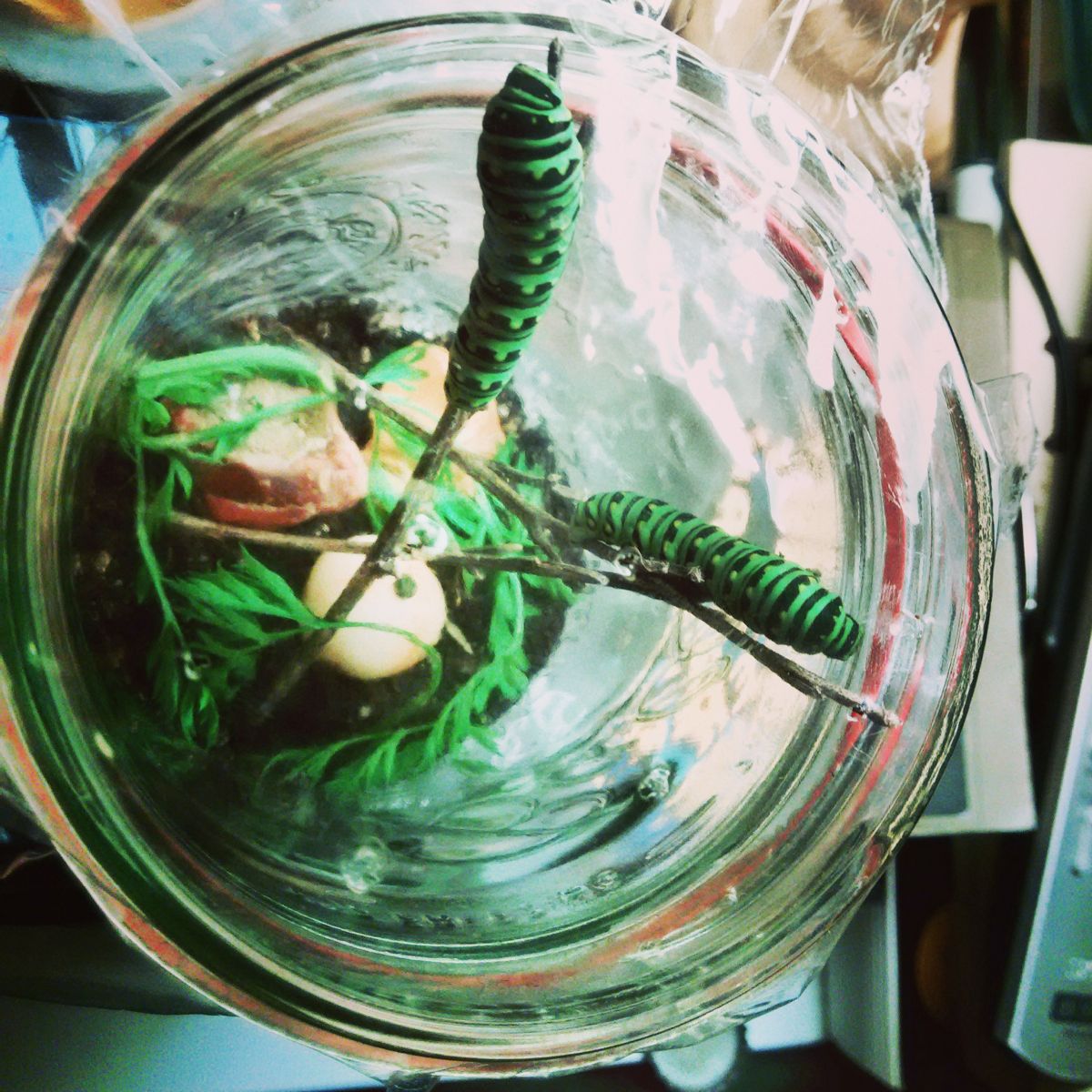
… and while weeding carrots. Lewis and Carroll near pupation size, feeding on carrots leaves. Madeleine took the last three photos.
Veggie List and Veggie Notes (July 2/3, 2015, purple EOW)
Strawberry season is over. We expected to pick the final berries this week, but pounding rain on Monday did them in. We will miss the berries, but our crew is glad to move on to other jobs.
‘Caraflex’ green cabbage, 1
Swiss chard, 1 bunch
Broccoli, 1 or 2 medium heads
Romaine lettuce
Sugar snap peas, 1.4 lb
Zucchini & summer squash, about 3 lb
Rhubarb, 1.5 lb
Garlic scapes, a handful
A few members will get one cucumber. We’ll have cukes for everyone next week.
Next week’s box will probably contain sweet Walla Walla onions, cucumbers, broccoli, greens, zucchini, herbs and more.
‘Caraflex’ cabbage – This ia a nice salad-type that we grow in summer. Don’t you love the pointy shape? It has thinner, more tender leaves than the usual green cabbage. Great in salads and slaws but can also be cooked. Here’s the description from the seed catalogue: “Inner leaves are tender, crunchy, and have an excellent, sweet and mild cabbage flavor. Perfect for summer salads, slaws, or cooked dishes.”
Swiss chard (pretty bundle of green leaves) – This is a close relative of spinach, but requires a bit more cooking. Use as a substitute in any recipe that calls for spinach, just cook the chard a little longer. Both stems and leaves are delicious. The stems requite longer cooking, so cut them free from the leaves when preparing. That allows you to cook the stems longer.
Rhubarb – We’re sending rhubarb so you can bake for your holiday parties!
Cucumbers (only a few members this week) – We should have cucumbers for everyone next week. If you do receive one this week, don’t be surprised if it’s a bit misshapen. Like zucchini, the first set of cucumbers are often odd.
THIS WEEK’S RECIPES
Comforting Classics
Rhubarb Charlotte
Fish and Wilted Swiss Chard Tacos with Shredded Lettuce and Chipotle Cream
Mac and Smoked Gouda with Broccoli
Stir Fry Rice Noodle with Snap Pea and Eggs
Laura’s Zucchini Bread
Napa Cabbage and Chicken Salad
Outside the Box Recipes
Rhubarb Vinaigrette
Greek Swiss Chard and Zucchini Soup
Broccoli and Gorgonzola Polenta
Lettuce Steamed Snap Peas
Zucchini Carpaccio
Cabbage and Shrimp Fritters
Kitchen Sink Recipe
Make a big old salad with any of the box ingredients and add the garlic scape dressing. Imagine the different textures if you grill your romaine and then top with raw, shaved zucchini or broccoli florets, chopped snap peas or sliced Swiss chard.
Grilled Romaine with Garlic Scape Dressing
Quick and Easy Dinner Idea
Lucky U-Pick
- On: June 24, 2015
 1
1
We had great conditions for our strawberry u-pick last weekend. The weather stayed dry despite storms in the area, and the picking was easy.
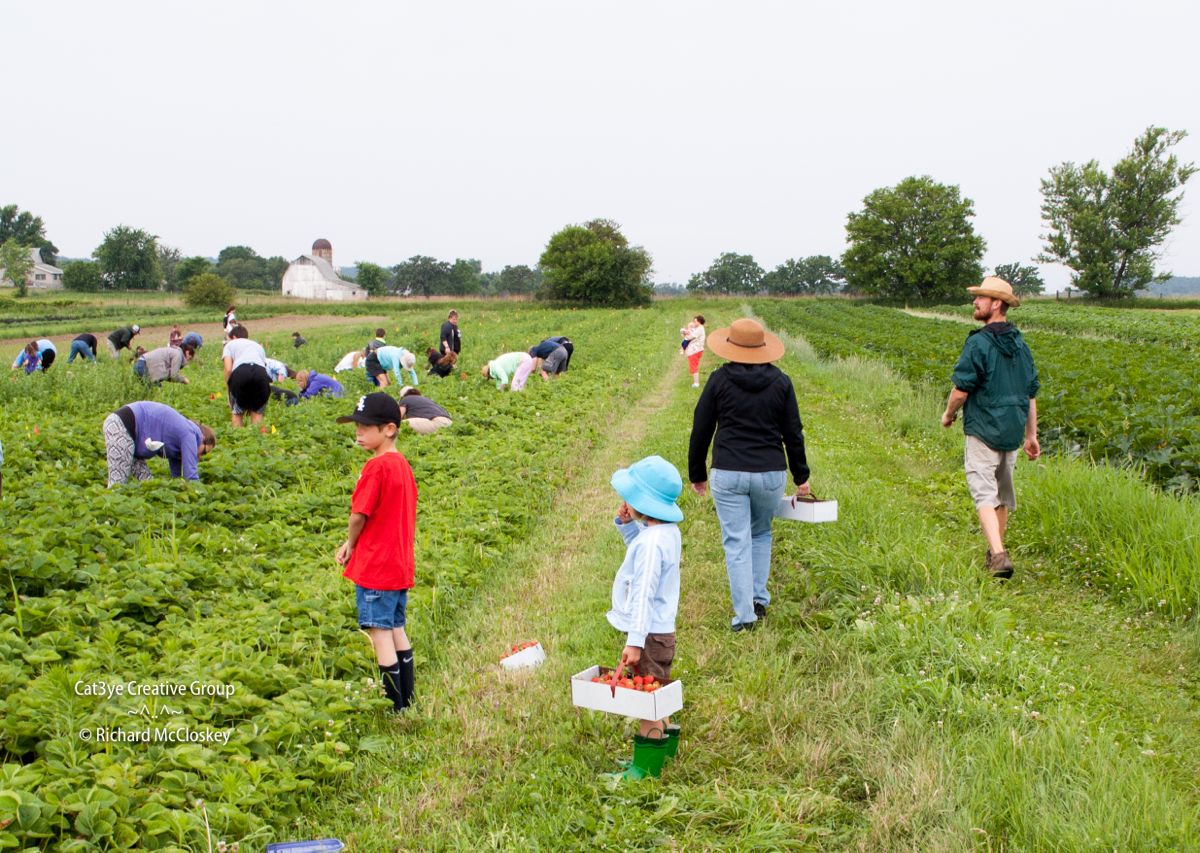
Billy (at right in green jacket) leads members to the berry patch.

Happy members with their berries.
Upcoming final strawberry u-pick
Read our June 24 email for info about the final berry u-pick.
Veggie List and Veggie Notes (June 25/26 2015, week #6, green EOW)
This box is designed for Asian salads or stir-fries, with napa cabbage, daikon, peas, scallions and garlic scapes.
Strawberries, 2 qt
Snap peas, 0.90 lb
Snow peas, 0.25 lb
(Both types of peas are in one bag.)
Napa cabbage
Daikon radish, 1 – 3 by size
Scallions, 1 bunch
Zucchini/summer squash, about 3 lb
Garlic scapes, a handful
Next week’s box will probably contain snap peas, garlic scapes, lettuce, Swiss chard, zucchini, broccoli and more. We’re not sure yet if there will be more strawberries.
Strawberries – Everyone gets two quarts again this week. Strawberries are perishable so don’t try to store these for long. Refrigerate. Compare the two containers, judge which berries are softer and more ripe, and eat those first.
Napa cabbage (large, pale green cabbage with crinkled leaves) – This is an interesting vegetable, useful for both fresh, raw salads and for cooking. These napa are large enough to split among several recipes. Napa’s most famous use is fermented kimchi. I like to prepare a fresh, unfermented kimchi. Same seasonings, but it’s ready to eat right away. You will be amazed at how much shredded napa cabbage shrinks when prepared this way. See here for an example, but cut the salt in half: Grilled Flank Steak with Kimchi-style Coleslaw.
Storage: Napa stores very well. Cut off wedges as needed and keep the rest covered and refrigerated, and it will keep for several weeks. Peel off the outer layer and it will be ready to use. Here are a few preparation ideas from the ‘Asparagus to Zucchini’ cookbook.
– Chop raw napa into green salads.
– Substitute napa in traditional coleslaw.
– Chinese cabbage cooks quickly. Steam 3-5 minutes, or until leaves are wilted down but remain slightly crisp.
– Substitute napa cabbage for common cabbage in recipes, but reduce the cooking time by 2 minutes.
– Napa cabbage is the main ingredient in egg rolls. Try making an egg roll mixture to eat as a cooked side dish instead of preparing time-consuming egg rolls.
Daikon radish (slender white roots) – These Asian radishes are good cooked or raw. We often make a sliced radish salad, with Asian-style dressing (rice vinegar, mirin, sesame oil, soy sauce, minced garlic). Even a brief marination mellows the radish’s sharpness.
Garlic scapes (curly green things) – Garlic scapes grow at the top of garlic plants. They look like flower buds but are actually clusters of tiny bulblets. We snap off the young scapes to direct the plants’ energy into forming garlic bulbs underground. Use scapes as a substitute for garlic cloves. They can be minced, mixed with olive oil, and added to stir fries or simple pasta dishes. The scapes can be sautéed, but will not brown like garlic cloves. Expect them to retain their crunch even when cooked, and to be milder than garlic cloves, closer in pungency to the green garlic we’ve sent. Most of this week’s scapes are from John Hendrickson of Stone Circle Farm who grows organic garlic for our CSA, but some are from our garlic field.
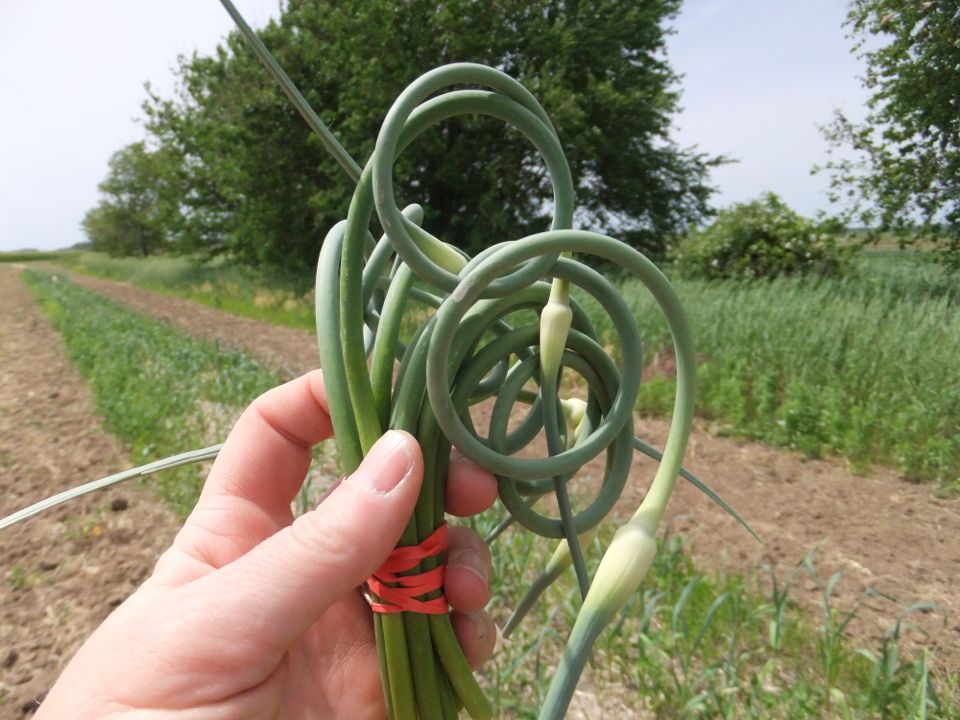
Garlic scapes
THIS WEEK’S RECIPES
Comforting Classics
Strawberry Shortbread with Whipped Cream
Smoked Trout Snap Pea Pasta Salad
Napa Cabbage with Coriander Butter
Napa Cabbage with Cannelini Bean and Kielbasa Sauté
Daikon Pickle
Chocolate Chip Zucchini Muffin
Outside the Box Recipes
Fresh Strawberry Daiquiri
Vegetarian Japanese Snap Pea and Napa Cabbage Soup
Singapore Curried Noodles with Napa Cabbage and Tofu
Kimchi-Style Sautéed Cabbage
Skillet Daikon Radish Fritters
Garlicky Thai Fried Rice with Snap Peas and Summer Squash
Kitchen Sink Recipe
Feel free to serve this over the sautéed napa cabbage or if you like your burger on a bun, tuck in some of the daikon pickles.
Turkey and Zucchini Burgers with Green Onion and Cumin
Quick and Easy Dinner Idea
Grilled Flatbread with Grilled Zucchini or Summer Squash and Snap Pea Puree
Strawberry weeks
- On: June 17, 2015
 2
2
This promises to be our best-ever strawberry crop. Eat ’em, pick ’em, this is the moment. Tipi members, read our June 17 email about two upcoming u-picks.
Strawberry season is a demanding time of year. Peas and strawberries are ready to harvest and both are time-consuming to pick. At the same time, we’re still planting and transplanting crops, yet earlier plantings need weeding. This happens every year. We’re all pitching in and working long hours as needed. The extra effort is worth it; the food this time of year is so delicious and the season so short!
Ginger
We doubled our ginger planting this year. Our small inaugural crop last year was a success. I ordered twice the amount of ginger ‘seed’ this year, an accomplishment as the seed is always in short supply. We buy from a farm in Hawaii that produces disease-free organic ginger seed. They are the only source worldwide right now, so we rarely receive the entire amount we order. I placed my order this winter minutes after they opened sales. The ‘seeds’ are just pieces of gingerroot which we plant in potting mix and keep warm until they sprout. It takes at least 6 weeks before they are ready to plant in the ground in our smallest greenhouse. It’s a great use for an under-utilized corner of the farm. We use this greenhouse for just a month in spring to harden off seedlings before they go outside. After that, it sits empty. Now we have a new use for it. We’ll give you an update in October – that’s when the ginger will be ready to harvest.
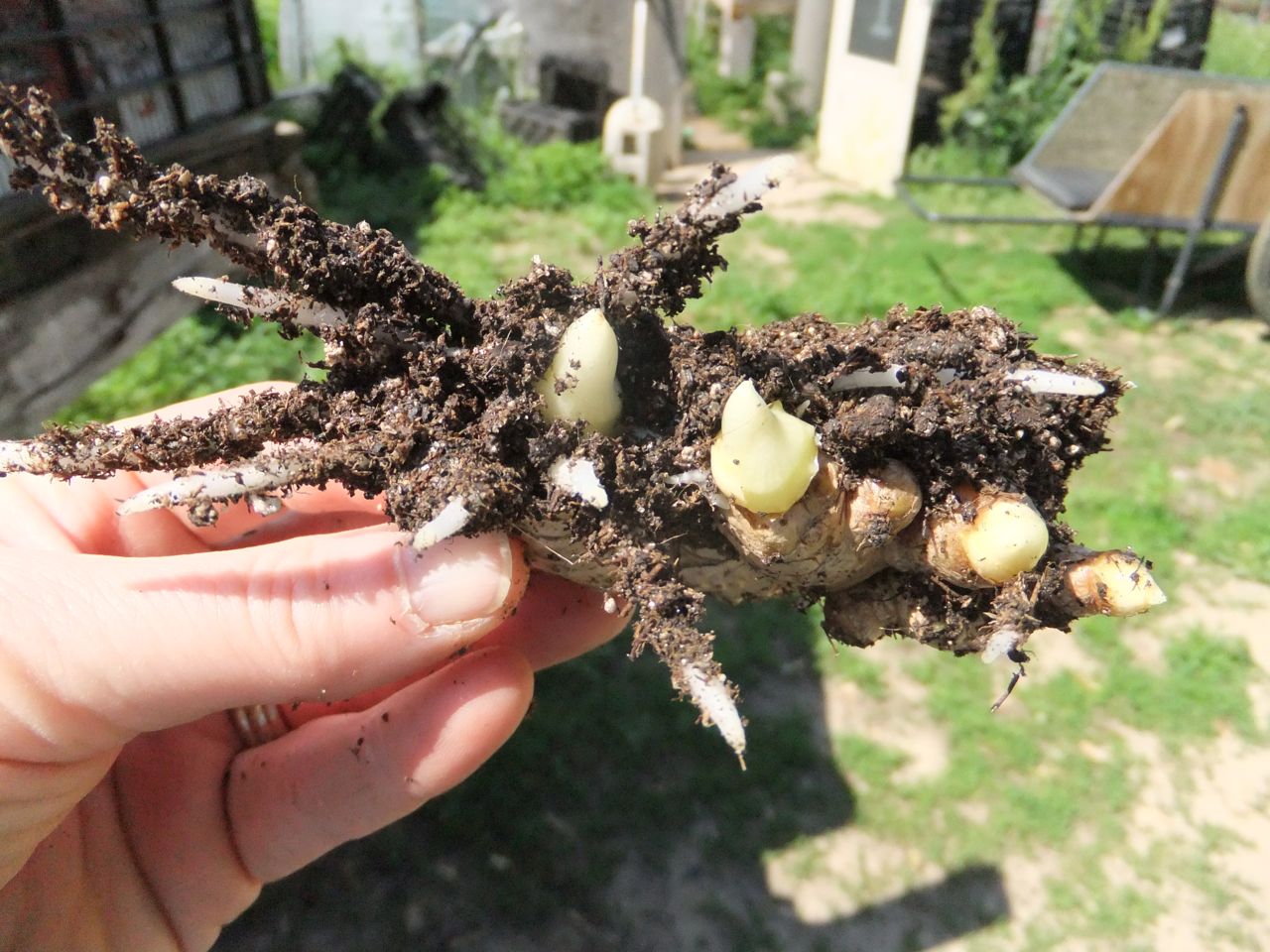
It’s important to pre-sprout gingerroot to get a jump-start on the long growing season needed to produce a crop. Planted into potting mix and kept warm, the gingerroot slowly forms buds and roots.
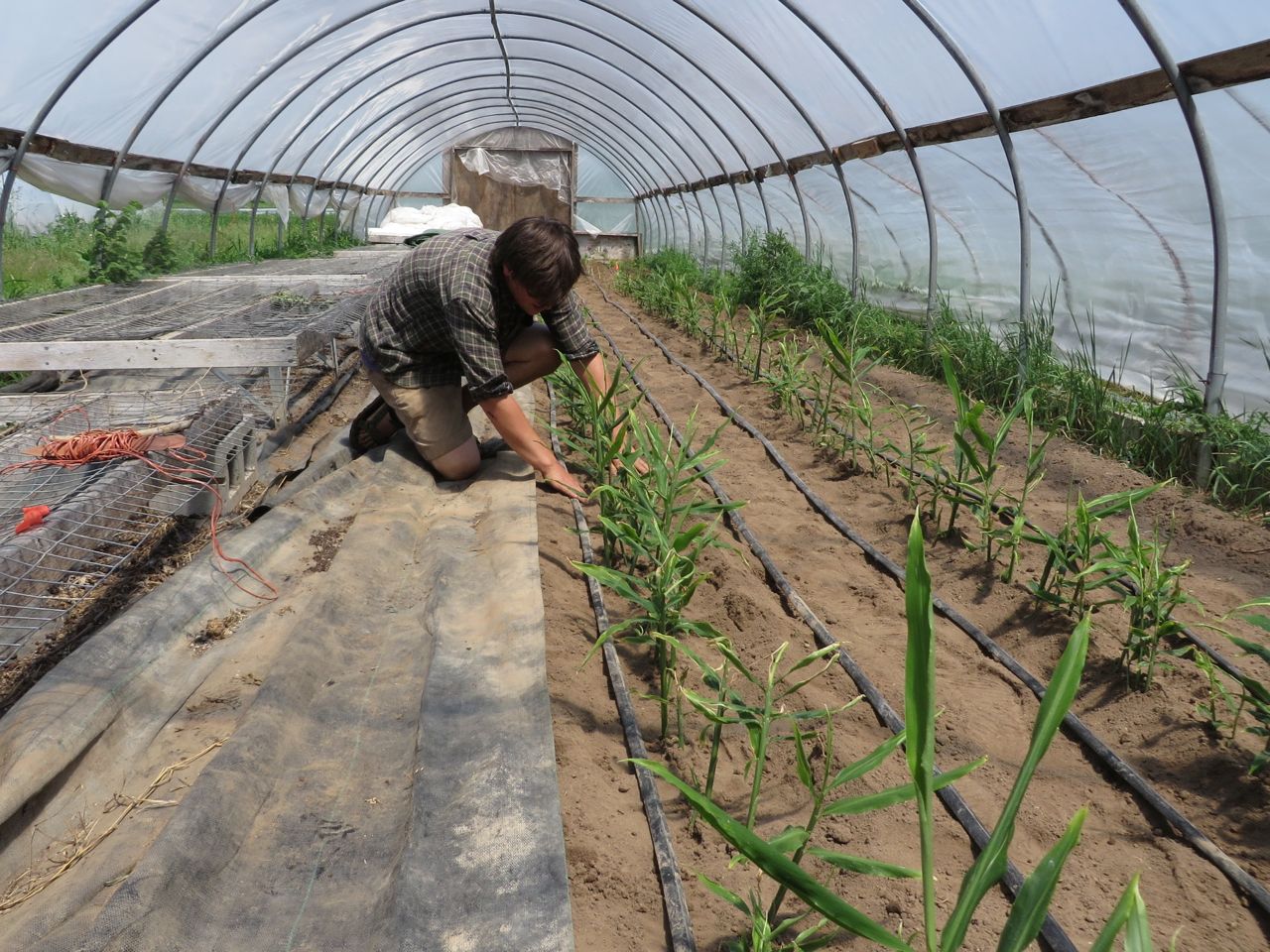
Jory tends young ginger planted in our smallest greenhouse.
Veggie List and Veggie Notes (June 18/19, week #5, purple EOW)
Strawberries, 2+ qt
Asparagus, 0.9 lb
Spinach, 1 bunch
Snap peas, 1.4 lb
Snow peas, 0.25 lb
Both types of peas are in one bag.
Broccoli, 1 medium head
Red bibb lettuce, 1 or 2
Zucchini/summer squash, about 2 lb
Scallions, 1 bunch
Next week’s box will probably contain strawberries, peas, zucchini and summer squash, scallions, garlic scapes and more delightful spring vegetables.
Strawberries! – We’ve been waiting for these.
♦ Ripe strawberries are always perishable but these are especially delicate because of rainy weather earlier this week. Ripe berries should be eaten immediately, or stored in the refrigerator. Most berries are quite clean. If you want to clean your berries, rinse gently. Don’t soak them, just rinse. Do not be concerned if you receive a partially-filled container. Sometimes we fill them partially in order to distribute berries to all the members.
♦ You will receive two or three containers of strawberries. Compare the containers, judge which berries are softer and more ripe, and eat those first.
♦ Please recycle your strawberry containers. We no longer collect them for re-use. Please don’t return them to your pick-up site.
Snap peas (plump pea pods) – These peas should be eaten pod and all. They are delicious raw, or very lightly cooked or stir-fried. They might need a quick rinse to remove faded gray blossoms. Store in the refrigerator. Here’s how to remove the strings from the snap peas. Snap off the stem end and pull the string down the concave side of the pod (the inward-curing side). Throw away the string and eat the pod.
Snow peas (flat pea pods) – These are excellent stir fried or in raw salads. The thicker pea pods will usually have two strings along the edges. Remove them when you snap the stem off.
Zucchini and summer squash – You will receive yellow summer squash or green zucchini. Some squash are oddly shaped but are fine to eat. This is typical for the first picking, and reflects that the first squash were not completely pollinated. The plants were hidden under row covers where pollinators couldn’t find them. The honeybees settled down to work once we removed the row covers. The young squash sizing up for the next picking look great.
THIS WEEK’S RECIPES
Comforting Classics
Broccoli Penne with Spinach Pesto
Salad with Roasted Asparagus, Hard Boiled Eggs, and Chickpeas
Precious Snap Pea Sauté
Strawberry Dessert Pizza
Shaved Zucchini Salad with Parmesan Dressing
Curried Steak, Radish, Zucchini and Snap Pea Stir Fry on Lettuce
Outside the Box Recipes
Sesame Wilted Spinach
Prosciutto Wrapped Grilled Asparagus with Fig Coulis
Quinoa Salad with Snap Peas
Strawberry Soup
Zucchini and Sugar Snap Pea Vietnamese Salad
Lettuce Pesto
Kitchen Sink Recipe
Some of our members like to make a big vat of something that uses up a lot of their veggies, then eat it all week — With this one, you can add just about any of the veggies in your box.
Quick and Easy Dinner
Spice Rubbed Zucchini Tacos with Scallions and Grilled Chicken
Always thinking
- On: June 10, 2015
 0
0
Fortunately for us, Steve loves tinkering with machinery. This week’s inspired idea? He tracked down parts to adapt our old strawberry planter to plant sweet potatoes. Steve bought the berry planter at a farm auction years ago. We haul it out of storage to plant strawberries – that’s all it’s been used for. Adapted with new sprockets to change the spacing, it worked perfectly to plant sweet potato slips.
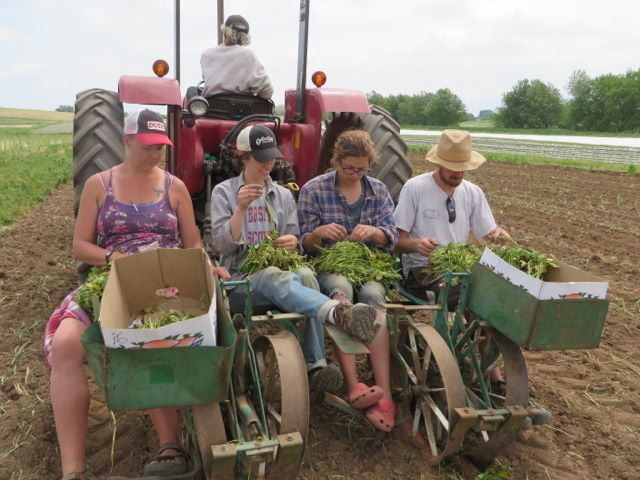
It’s a cozy garden party on the back of the berry planter. From left, Madeleine, Lizzy, Kelcie and Billy place sweet potato slips. Steve drives the tractor.
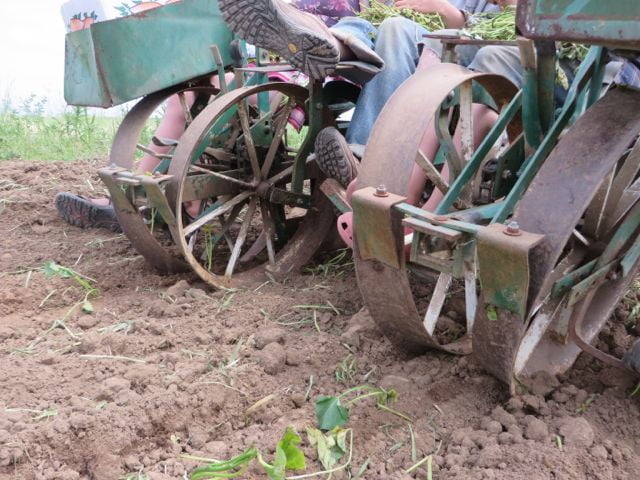
Rusty but reliable, the planter gets the job done.

This small team finished the sweet potato field in one hour. Compare with last years effort …
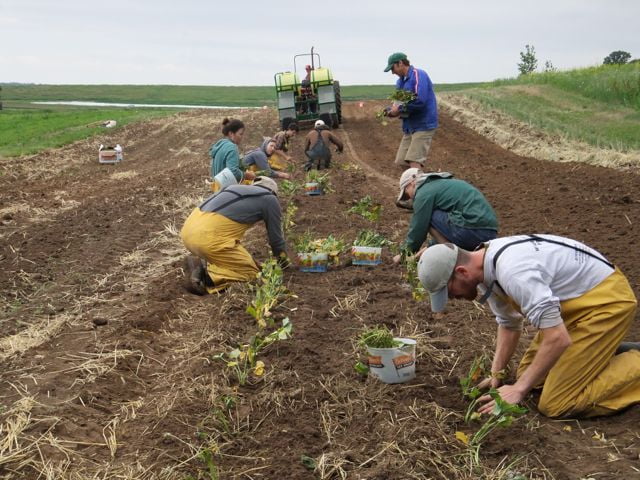
… which took nine people four hours, and was a more difficult, physical job.
Grilled Asparagus
Farming is unpredictable. There are two farm innovations in this story, one successful, one not. Steve had a new idea for the asparagus field this spring. As usual, he mowed down last year’s foliage in April, then shallowly tilled the field to kill off emerging weeds. Just before the asparagus emerged in late April, Steve tilled the field a second time. He’s never done this second tilling, but we have a new tiller with excellent depth control, so it seemed a good step to keep ahead of the weeds. Bad idea! The second tilling brought up a huge flush of ragweed, a particularly aggressive weed.
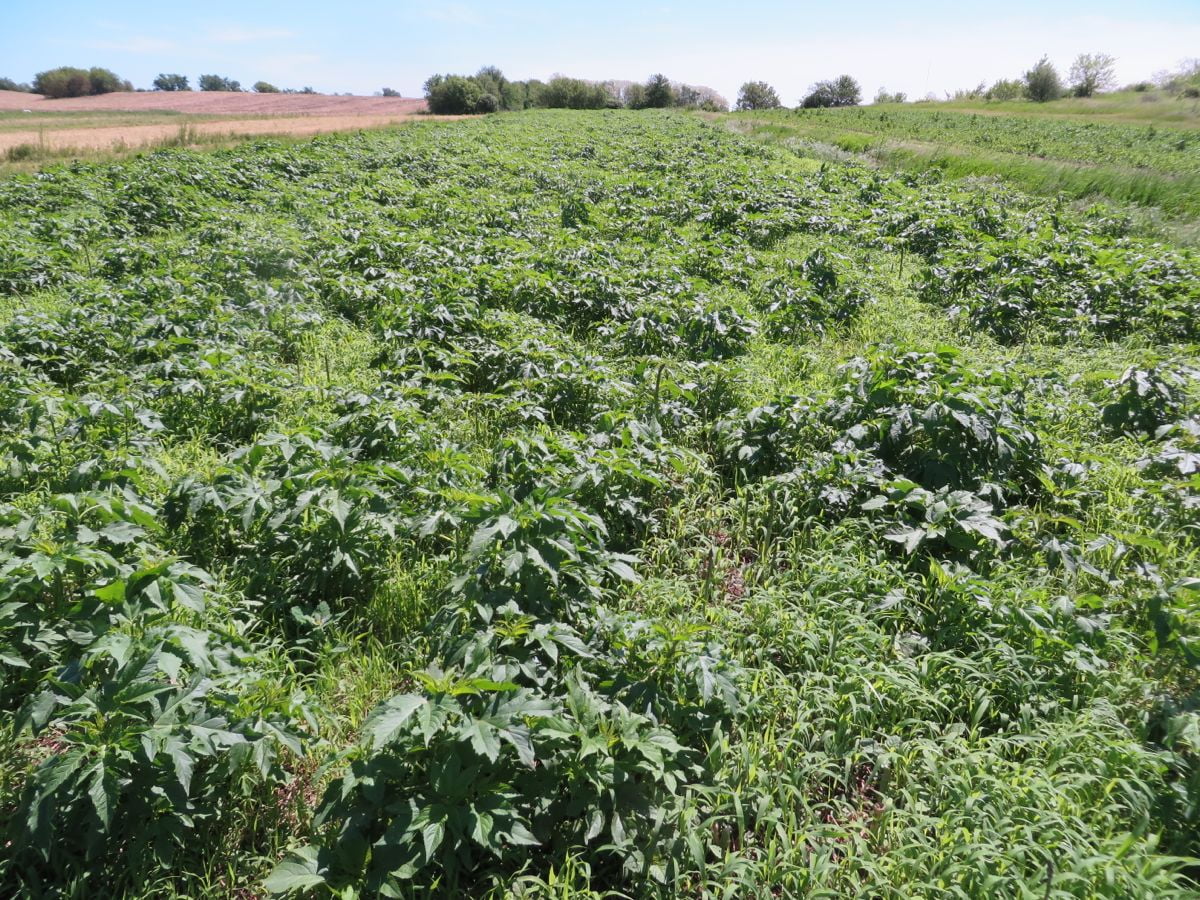
The ragweed overwhelmed the asparagus by late May. If you look closely, you can see a few asparagus spears poking up. We had to do something drastic or harvests would be finished for this half-acre field. Hand-weeding was out of the question; hoeing would damage the asparagus tips growing beneath the surface. Plus, it’s a daunting job to add at a busy time of year.
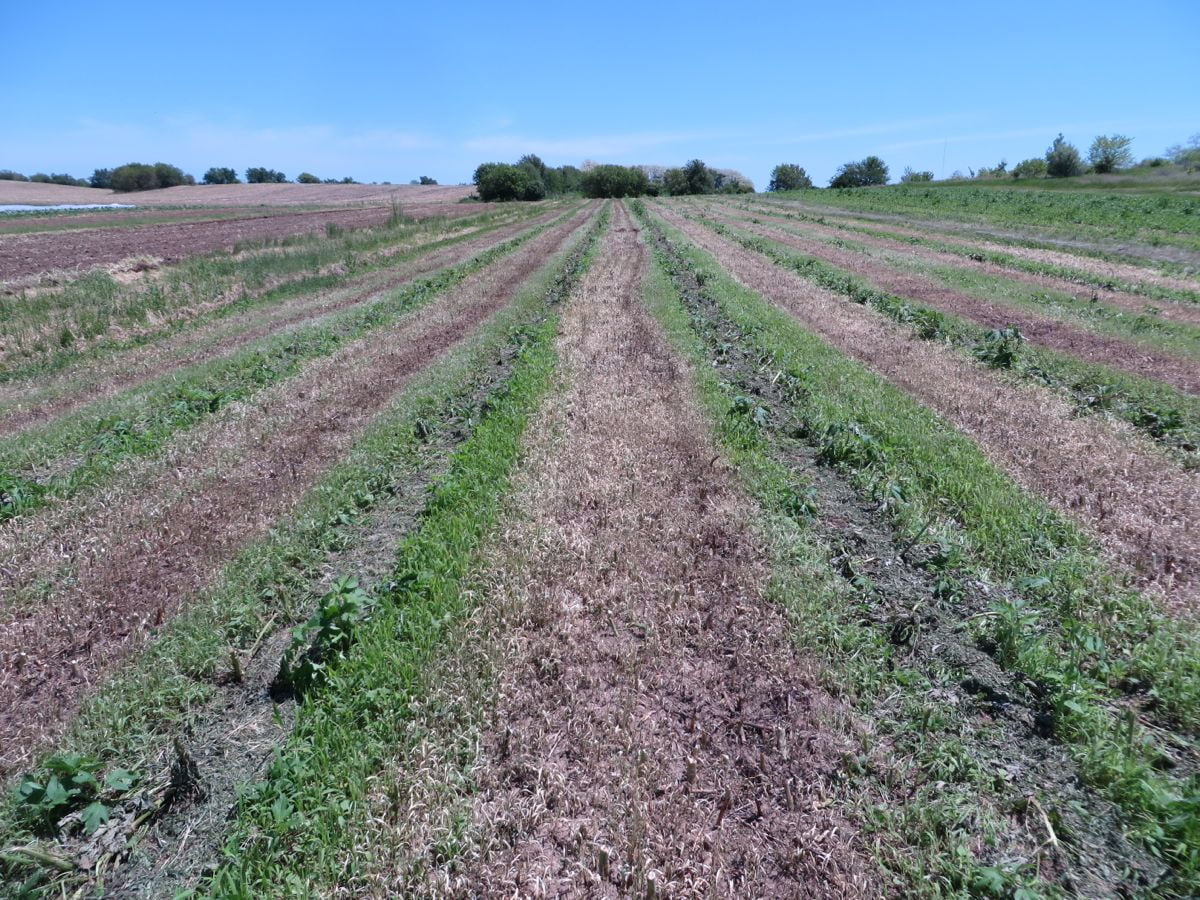
Steve tried something new. He mowed down the weeds, then went over the asparagus beds with his LP-fueled flame weeder to scorch the weeds. We didn’t know if this would work.
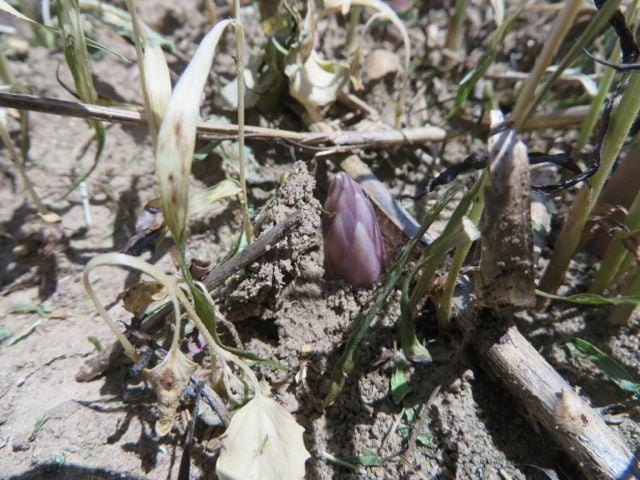
Fresh, undamaged asparagus emerged the next day.
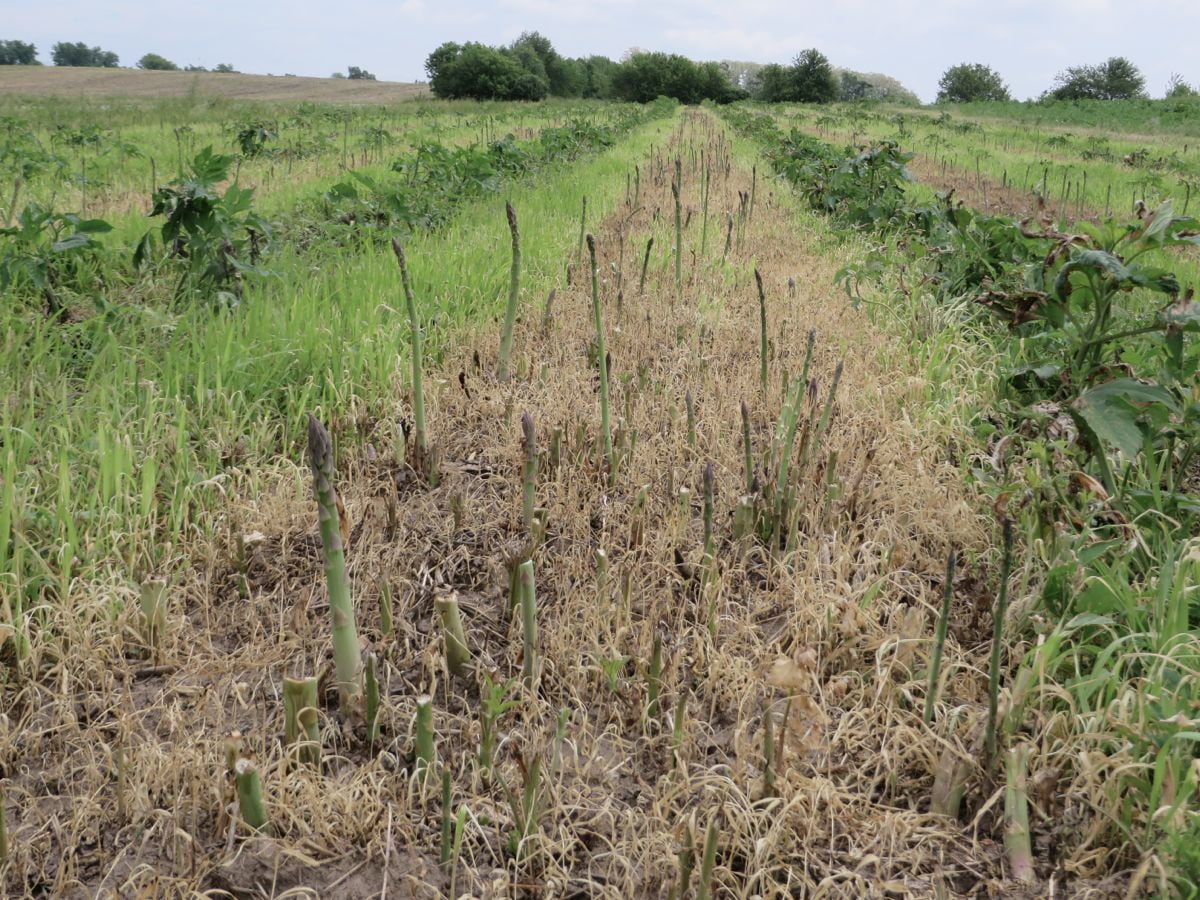
One week later, it was clear the flaming worked. The ragweed in the tractor wheel tracks survived but that’s not a concern. We will till those weeds after our asparagus harvests are finished. Steve’s maneuver let us pick asparagus for you for an extra three weeks!
Veggie List and Veggie Notes (June 11/12, 2015, week #4, green EOW)
Asparagus, 1.25 lb
Spinach, 1 bunch
Green leaf lettuce
Green kale, 1 bunch
Scallions, 1 bunch
Kohlrabi, 1
White salad turnip, 1 big
Cilantro
A few of our Thursday sites will get 1 pint strawberries. We will have berries for everyone next week.
Next week’s box will probably contain strawberries, sugar snap peas, asparagus, spinach, lettuce, scallions, some type of greens and more. Garlic scapes and daikon might be ready next week.
Spinach (bundle of dark green leaves) – This week’s spinach is from a new planting. It’s in perfect condition, which made harvest an easy job for the crew. Good for salads or cooking.
Green kale (bundle of dark green, frilly leaves) – Super nutritious, this first picking of the year is great cooked or used in raw salads like the one from Local Thyme this week.
Kohlrabi (pale green, round vegetable with thick skin) – Crunchy and sweet, kohlrabi is a great addition to salads.
Storage: Kohlrabi bulbs will store for a month in the refrigerator.
Uses: Kohlrabi are good peeled and eaten out of hand, or added to sandwiches. It is good mixed into salads, or prepared as a salad on it’s own. You can grate it, slice it, or cut it into matchsticks. It’s also good cooked. If you have it, the Asparagus to Zucchini cookbook has a long list of kohlrabi suggestions.
White salad turnip (white, round vegetable with thin skin) – Jon calls these our ‘early watermelons”: sweet, succulent and oddly large. Our turnips rarely grow to this size while staying such high quality. We snack on them in the fields, skin and all. Great for salads too.
THIS WEEK’S RECIPES
Comforting Classics
Raw Kale Salad with Pine Nuts and Currants
Kohlrabi Kimchee
Pinto Bean and Salad Turnip “Macos” or Ground Turkey and Salad Turnip “Macos”
Scallion Vinaigrette
Braised Asparagus with Feta and Lemon
Raw Spinach Wraps with Hummus and Vegetable Sticks
Outside the Box Recipes
Kohlrabi and Salad Turnip Wasabi Salad
Quinoa, Spinach and Egg Breakfast Bake
Curried Kohlrabi and Salad Turnip Rice Pilaf
Greek Kale and Spinach Fritters
Scallion Barlotto (Barley Risotto)
Asparagus Gribiche
Kitchen Sink Recipe
This is a recipe that is very flexible — you can add just about any, or all of the veggies in your box.
Kohlrabi, Kale and Salad Turnip Soup with Kidney Beans
Quick and Easy Dinner Idea
Big bang moment
- On: June 03, 2015
 0
0
Steve loves transplanting season, and marvels how quickly a compact mass of seedlings expands to fill our farm. Two wagonloads of tomato seedlings expand into 1.3 acres in the field. Can we continue that expansion for the next 13 billion years? No, probably not.
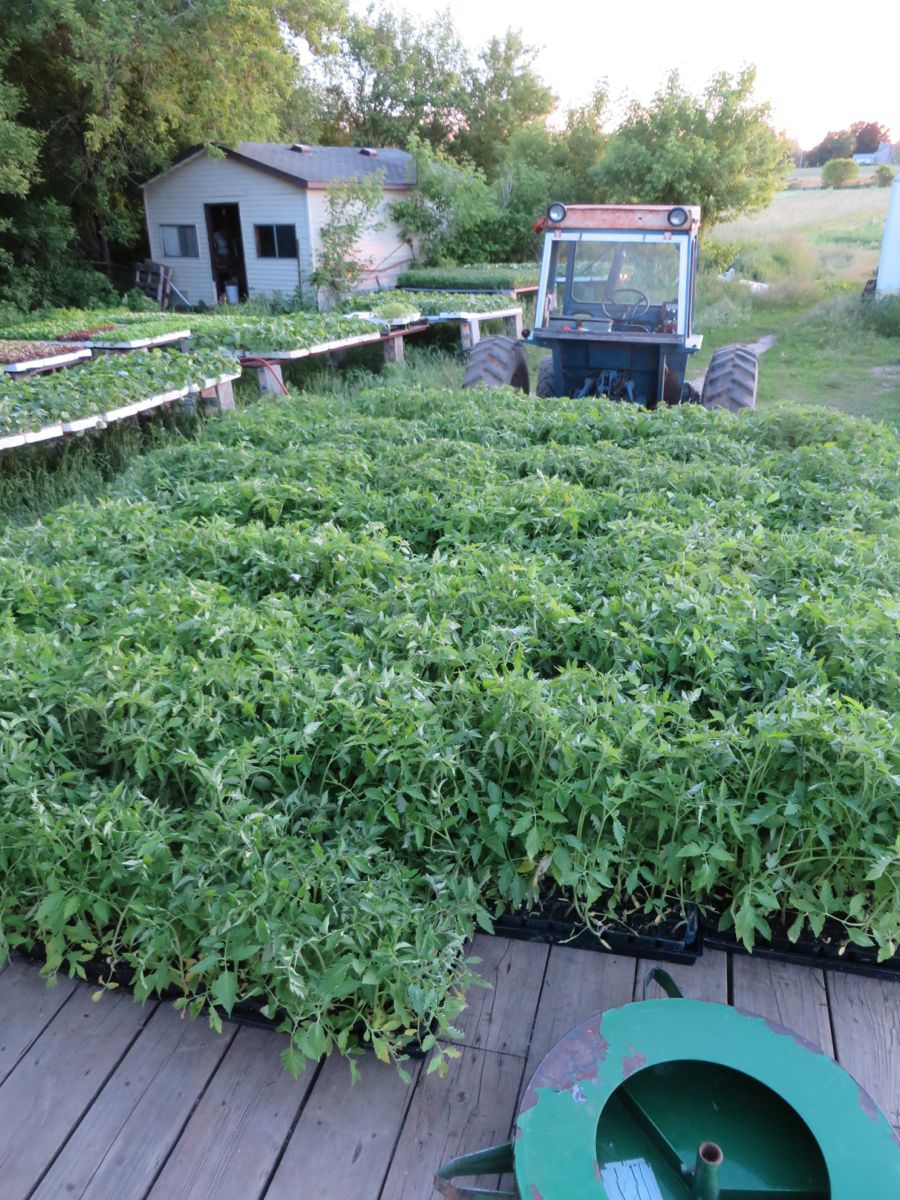
Tomato seedlings await transplanting. The green wheel is for our mechanical transplanter. It digs holes at a regular spacing.
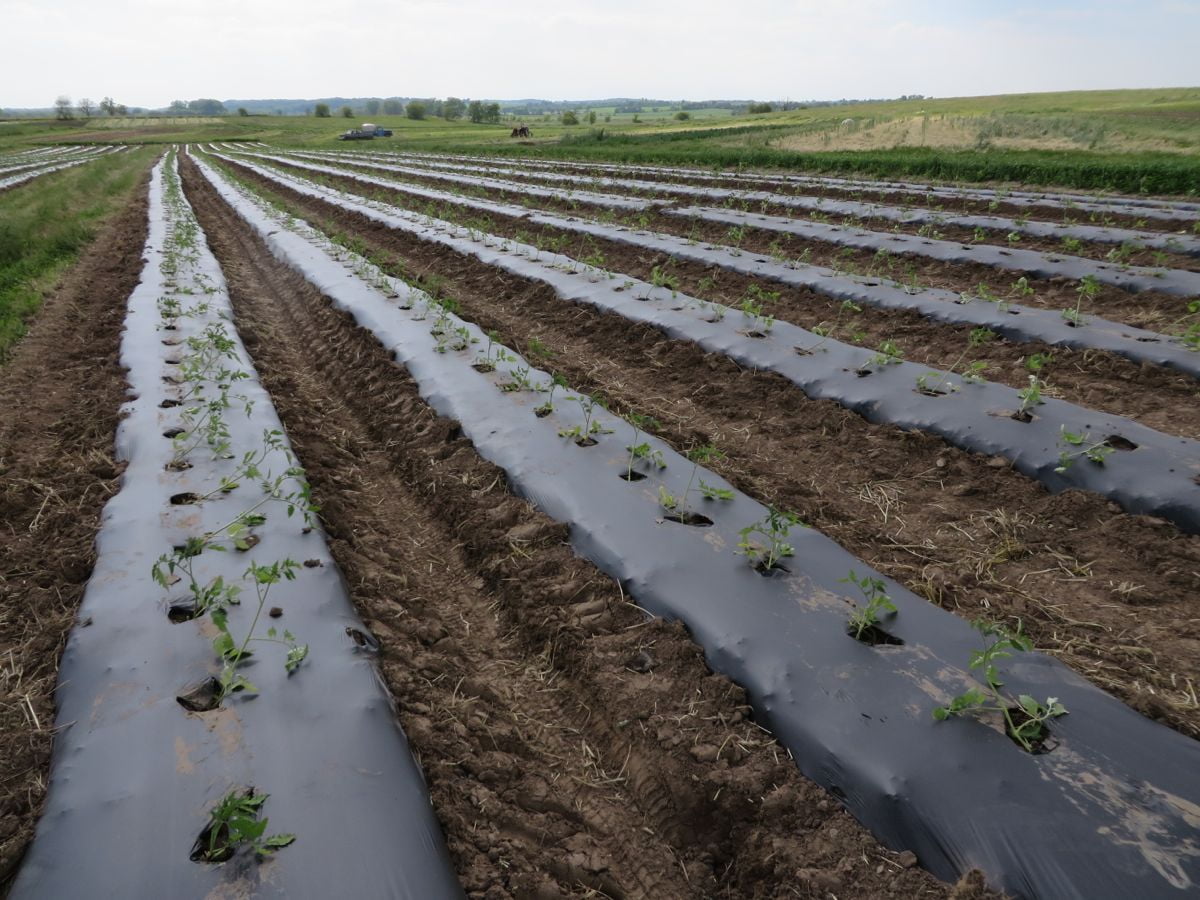
The seedlings on the wagon filled this 1/2 acre field.
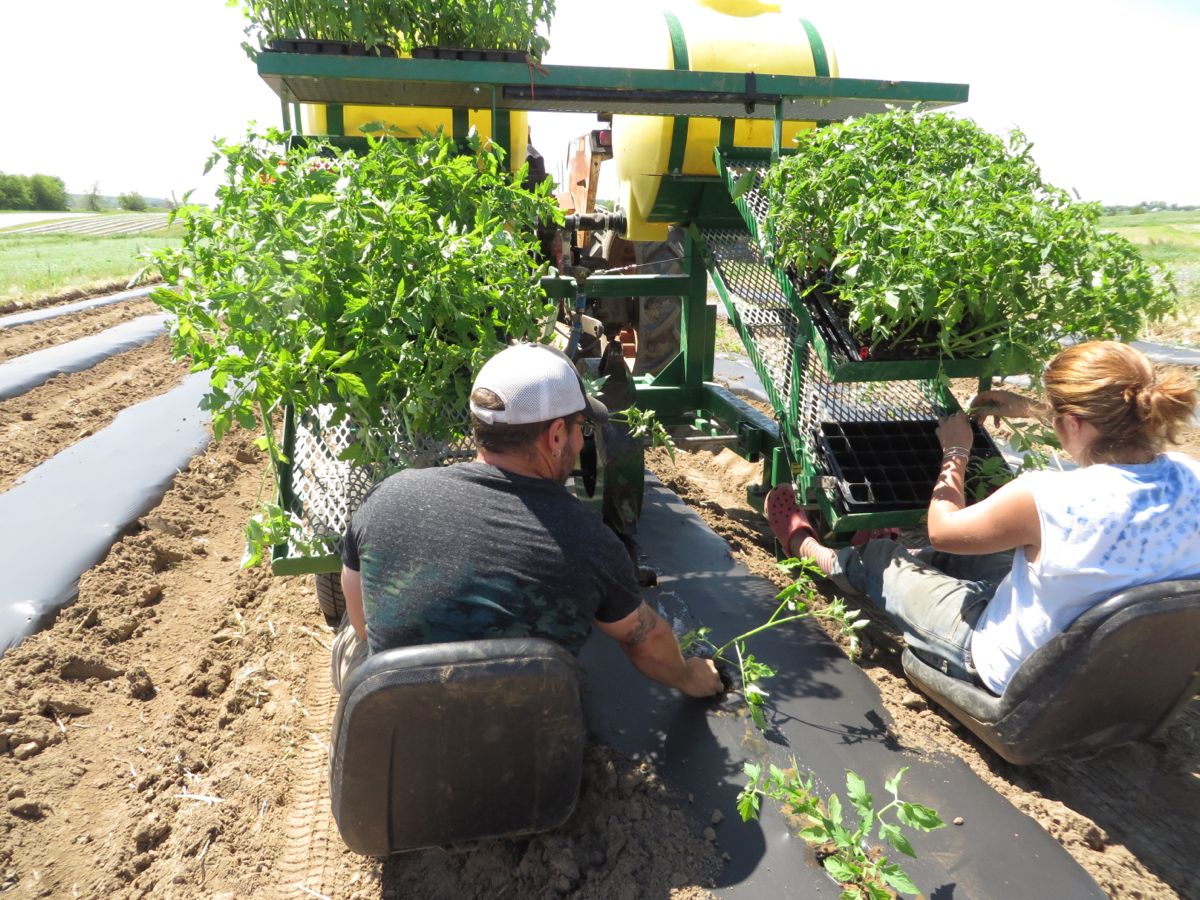
The seedlings go in quickly with our transplanter and crew …
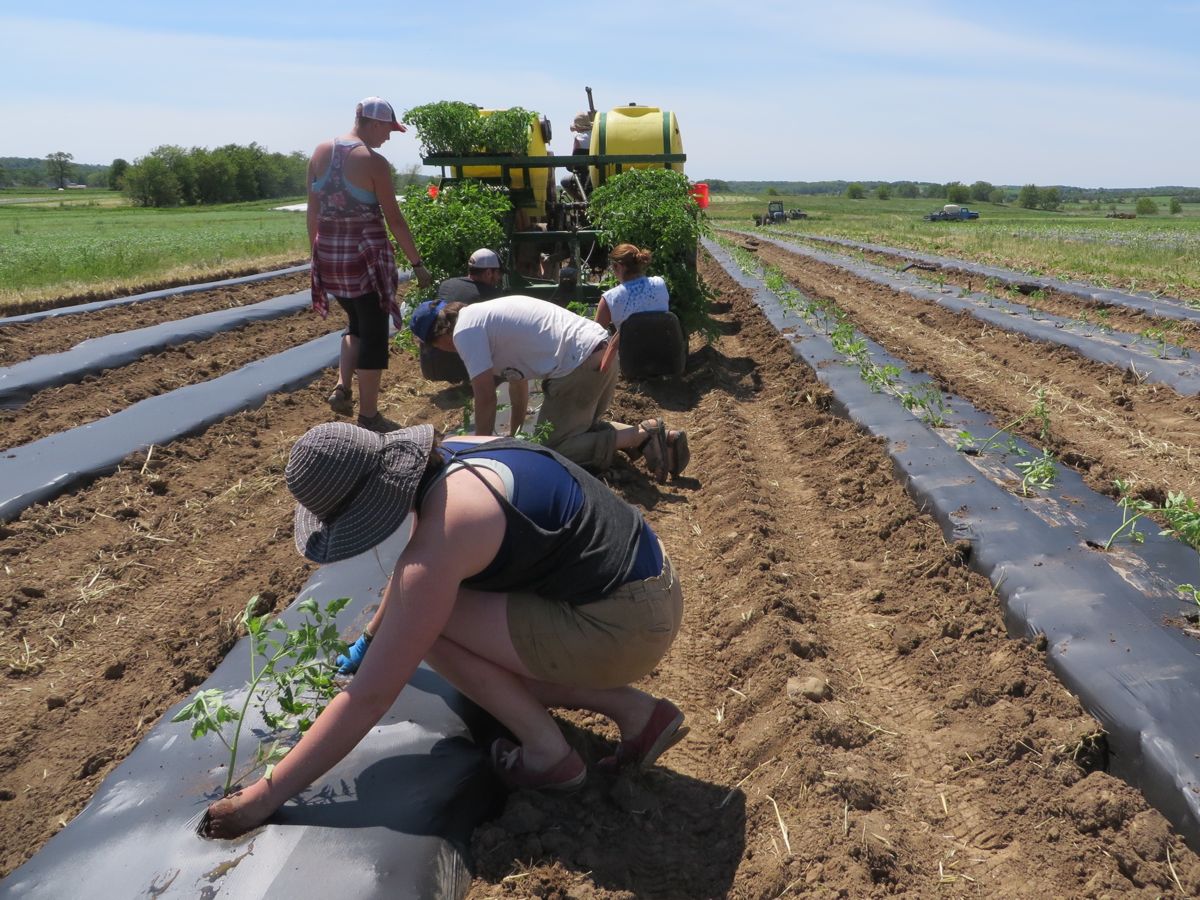
… followed by more people to set the plants in place. The tomato plants are leggy. Our transplanting schedule was thrown off by rainy weather. They will recover but it’s not the best start.
Tweak of the week – Something new and interesting this week.
We strive to make improvements every season. Innovation keeps farming fresh and interesting for us. New this year, we interspersed alyssum seedlings into our early lettuce and bok choy plantings. We hope to control aphids, an insect which has been problematic on these spring vegetables the last few years. Alyssum is an ‘insectary plant’, a host for beneficial insects that prey on crop pests. New research shows that interspersing 1 or 2 alyssum per 50 lettuce seedlings is enough to control aphids as effectively as conventional pesticide sprays. How cool! Sure, the alyssum displaces some harvestable lettuce but is worth the trade-off for higher quality. So far, our lettuce remains clean of aphids this year.
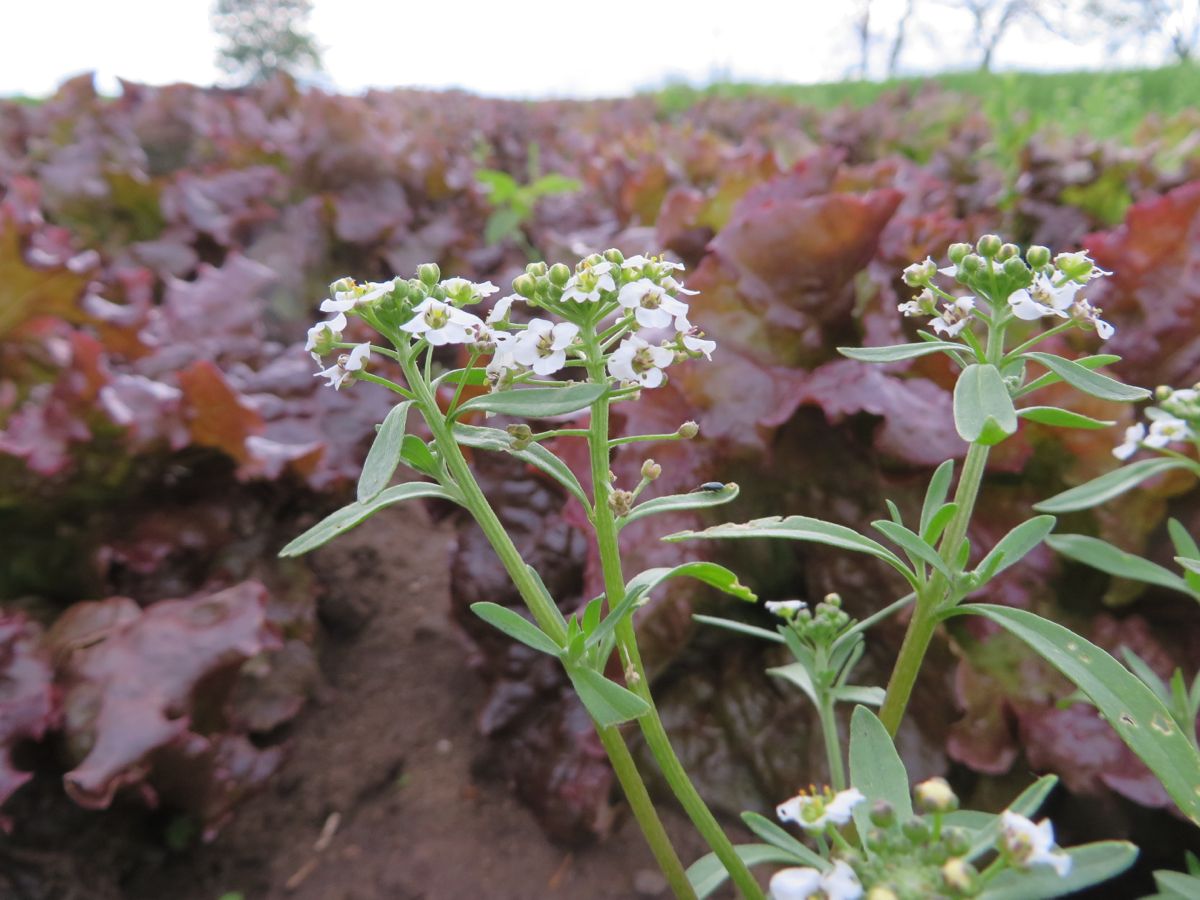
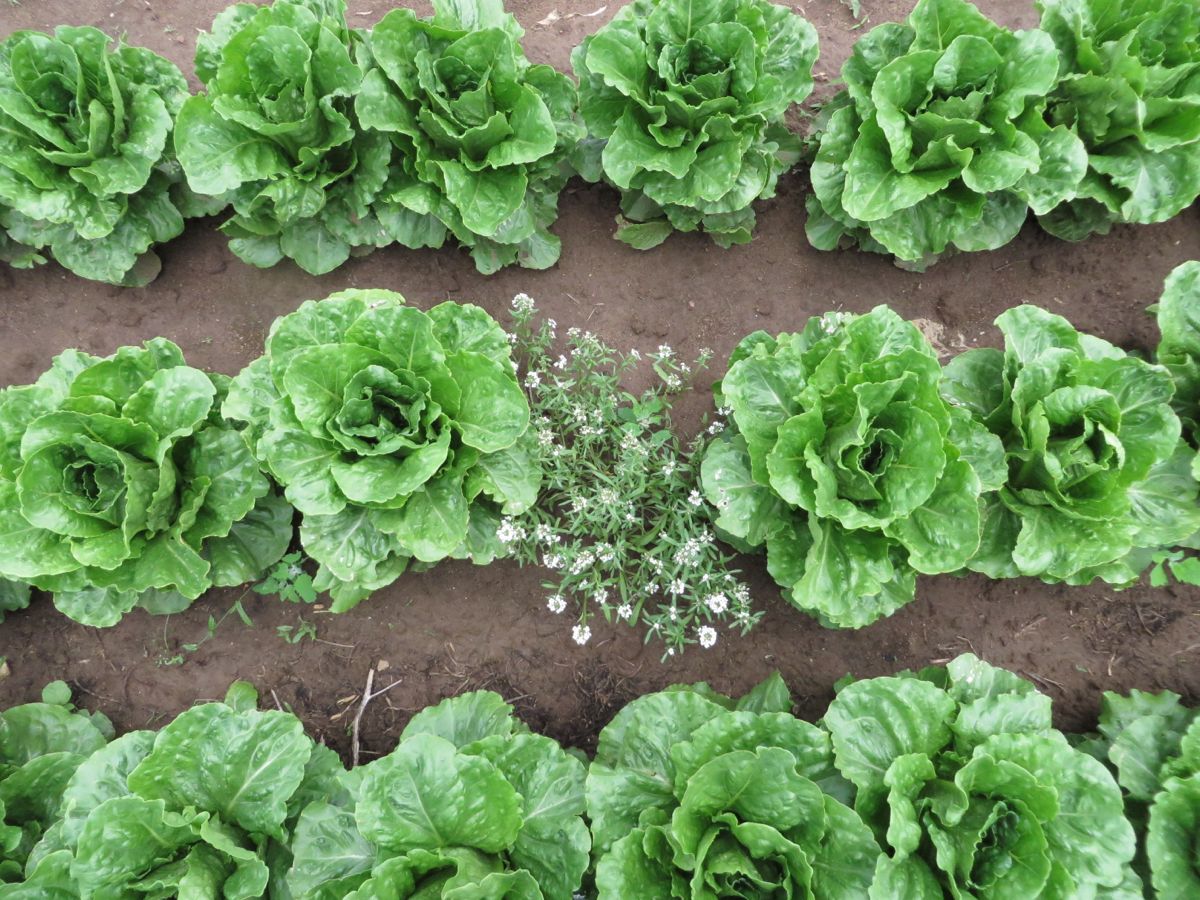
(top) Alyssum flowers with red bibb lettuce in background. (bottom) Alyssum interspersed among Romaine lettuce.
Veggie List and Veggie Notes (6/4/15, week #3, purple EOW)
This is a box of completely green vegetables. I asked Pat Mulvey to focus on recipes for leafy greens this week. They are big and abundant. If there are more greens than you will use promptly, consider freezing your extras. Steam, chop coarsely and freeze. Add the frozen greens later to casseroles and soups. You’ll be glad you have them. We encourage you to wash your produce carefully again this week (especially asparagus, Romaine, escarole and spinach) because of the recent rains.
Asparagus, 1 lb
Escarole
Romaine lettuce
White salad turnips with greens, 1 bunch
Spinach, 1 bunch
Scallions, 1 bunch
Cilantro, 1 bunch
Next week’s box will probably contain asparagus, kale or collards, lettuce, spinach, kohlrabi, scallions, cilantro and (maybe) more.
Escarole (large head of wavy green leaves) – This member of the chicory family can be eaten raw or cooked. Its slightly bitter flavor is a good addition to mixed salads. It is excellent cooked alone or mixed with other greens. It cooks quickly, but not as quickly as spinach. Cover and refrigerate.
Romaine lettuce (tall head of lettuce with crisp leaves) – More sturdy and less fragile than our other spring lettuces. Great for salads.
White salad turnips (white roots with tender greens) – The greens are particularly nice this week. We just started harvesting from a new field so the roots are a bit smaller than last week.
Scallions (bundle of green onions) – These are useful raw or cooked. Thinly-sliced raw scallions can be folded into biscuit dough or sprinkled on top of soups or salads. Terrific garnish for pasta dishes in combination with cilantro. Think pad thai.
Cilantro (bundle of aromatic leaves) – This herb is good in salsa, chutneys and salad dressings, or added to stir-fries. Used in Mexican, Asian and Indian cooking.
RECIPE FROM BETH; Caesar Salad, made safely with cooked egg yolks.
I love Caesar salad but gave it up years ago. Who wants to eat raw eggs? Lo and behold, there are ways to prepare it safely. Food scientist Harold McGee has developed a method that works. Many Caesar salad recipes call for 10 Tbsp. oil, but you can reduce the oil to 6 Tbsp. (total canola + olive) and the dressing still works.
Harold McGee’s method to sterilize egg yolks
Use a clean fork at each step to avoid re-contaminating the cooked yolks.
2 large egg yolks
1 & 1/2 tsp. water
1 tsp. lemon juice
Mix the ingredients in a clear glass bowl and beat together with a fork. Cover the bowl and microwave on high power until the mixture bubbles (about 45 seconds). Uncover and stir with a clean fork. Cover and microwave until it bubbles again (about 20 seconds) and let it bubble 5 to 10 seconds more. Stir again with another clean fork. Let cool. The mixture will be custard-like.
Caesar Salad
2 large eggs yolks, cooked as described above and still in the clear glass bowl
2 – 3 Tbsp. lemon juice
1 tsp. Worchestershire sauce
1 clove garlic, grated
2 tsp. anchovy paste
5 Tbsp. olive oil (or as little as 3 Tbsp.)
5 Tbsp. canola oil (or as little as 3 Tbsp.)
3/4 cup grated Parmesan cheese
black pepper
croutons
1 head Romaine lettuce, cut into 2-inch pieces, washed and carefully dried.
Note: Our Romaine vary in size. Start with half your Romaine, and gradually toss together with the dressing to be sure you have the right amount of lettuce.
1. Add the lemon juice, Worchestershire sauce, garlic and anchovy paste to the cooked egg yolks. Stir together with a fork. Let stand 5 – 10 minutes.
2. Slowly drizzle the canola and olive oils into the mixture while beating with a fork to emulsify. Stir in 1/2 cup Parmesan and black pepper to taste.
3. Mix the dressing with the prepared Romaine and croutons in a large bowl and toss to coat. Taste and add the remaining 1 Tbsp. lemon juice if needed. Sprinkle remaining Parmesan over top. Serve.
LOCAL THYME RECIPES
Comforting Classics
Classic Warm Spinach Salad or Warm Spinach and Shiitake Salad
Steamed Salad Turnip with Greens
Italian Escarole Wedding Soup and Vegetarian Italian Wedding Soup
Southwestern Caesar
Scallion and Cilantro Pancakes
Cilantro Chimichurri with Scallions
Outside the Box Recipes
Green Curry Simmered Veggies
Salad Turnip with Miso Ginger Vinaigrette
Escarole and Apple Salad
Teriyaki Asparagus Romaine Stir Fry
Fried Scallions
Salad with Lime Soy Cilantro Sauce
Kitchen Sink Recipe
This is a recipe that is very flexible — you can add just about any, or all of the veggies in your box. Grill some scallions, romaine and salad turnips and toss them on too!
Grilled Pizza with Wilted Spinach and Shaved Asparagus
Quick and Easy Dinner Idea
Our tough mudder
- On: May 27, 2015
 3
3
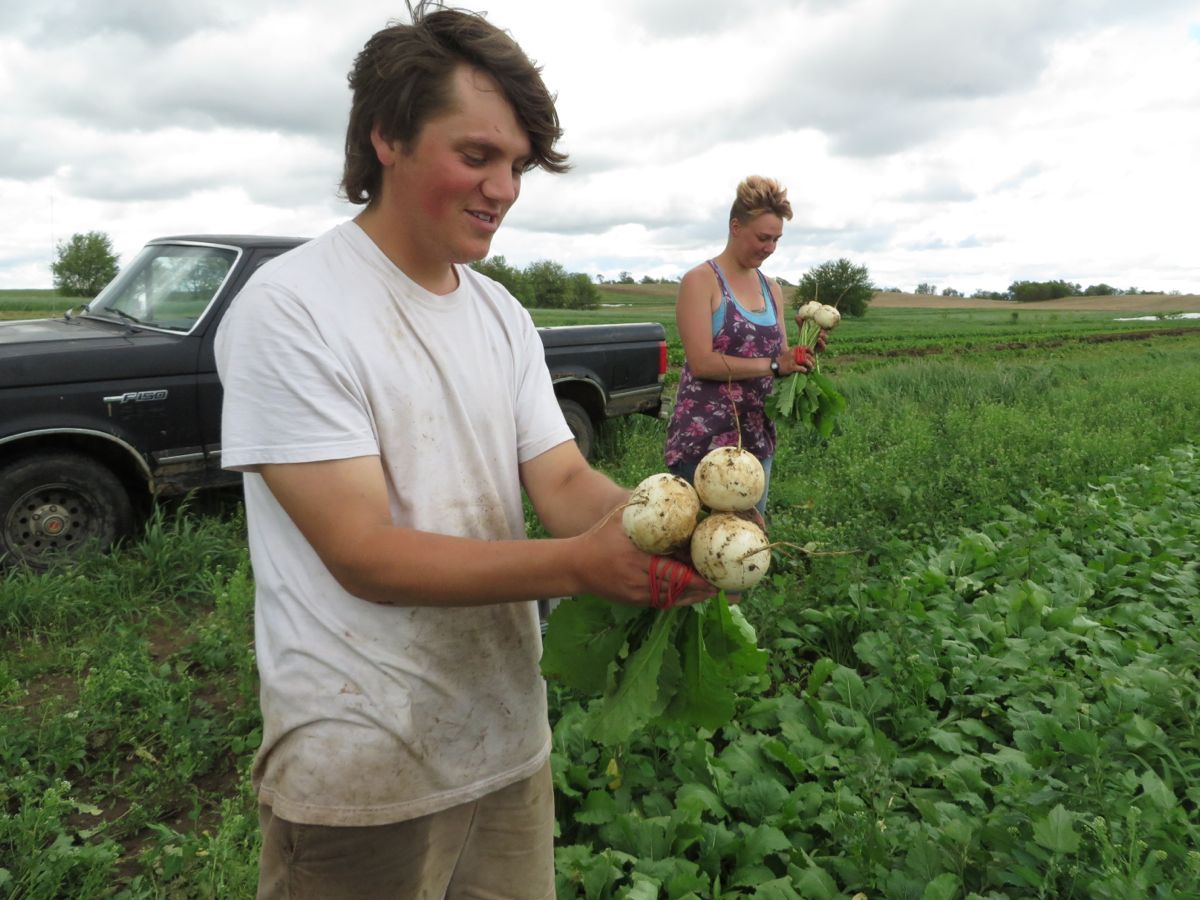
It was a muddy week for people and for vegetables. Above, Jory and Madeleine harvest white salad turnips shortly after the rain stopped.
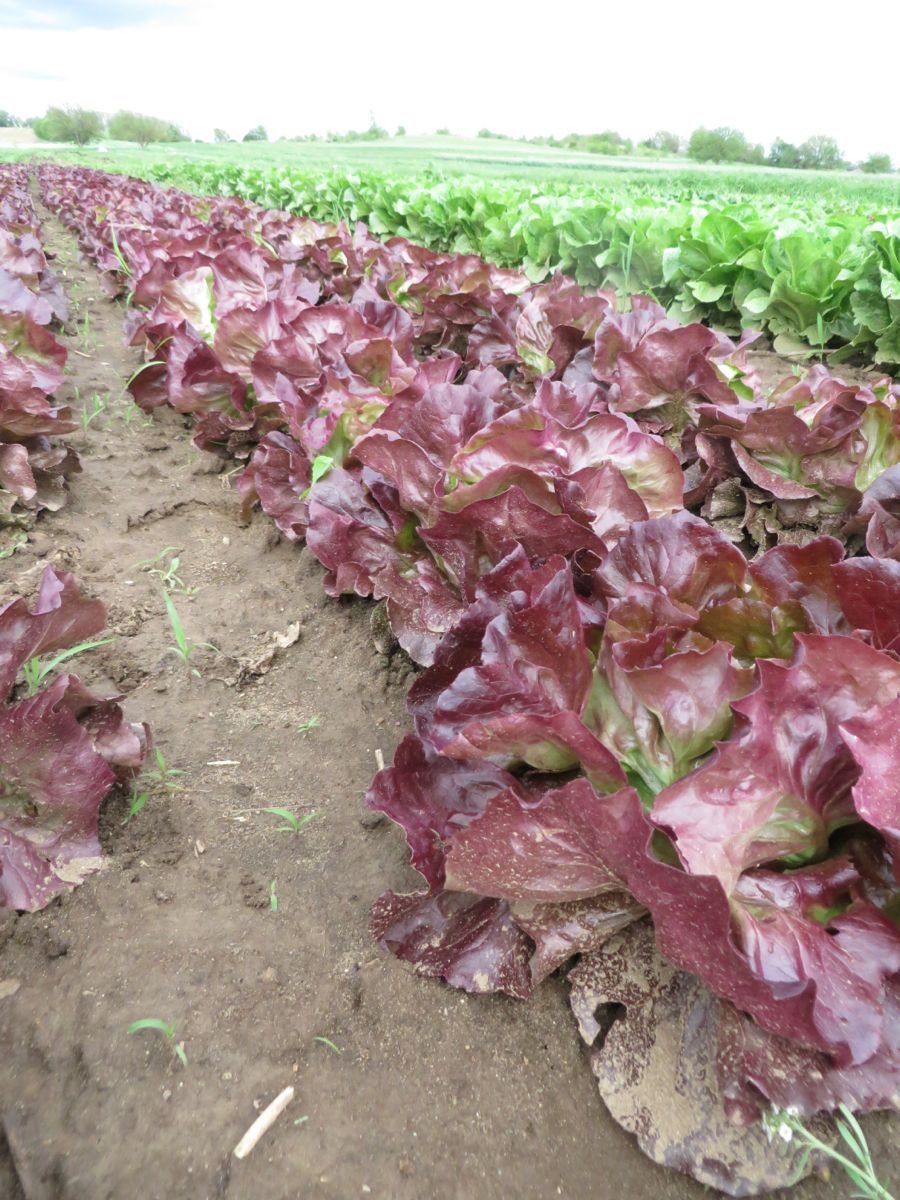
Heavy rains splash soil everywhere.
How to wash gritty lettuce and spinach
There were heavy rains this week. All the vegetables will need a little extra TLW (tender loving washing) this week. Vegetables that grow as a ‘head’ need extra attention after rainy weather because soil splashes into the head. Lettuce, bok choy, escarole, endive, turnip greens and spinach are all affected. Here is a technique to remove soil or grit. Run a sink or tub full of cold water. Cut the head of lettuce across the base so the leaves all fall apart. Cut it into smaller pieces if you wish. Submerge the cut lettuce in the water and swish gently. This week’s red bibb is VERY tender and fragile, so be gentle. Pull from the water and let drain. Repeat. The draining action pulls the dirt off the leaves. Repeat with a second tub of clean water if needed. If you don’t plan to eat all the lettuce (or other green) immediately, dry it in a salad spinner and store in a dry container.
June 1 check reminder
Many of you paid us with checks post-dated to June 1. Remember? I will deposit your June 1 checks on Monday June 1.
Farm News; two exciting forecasts
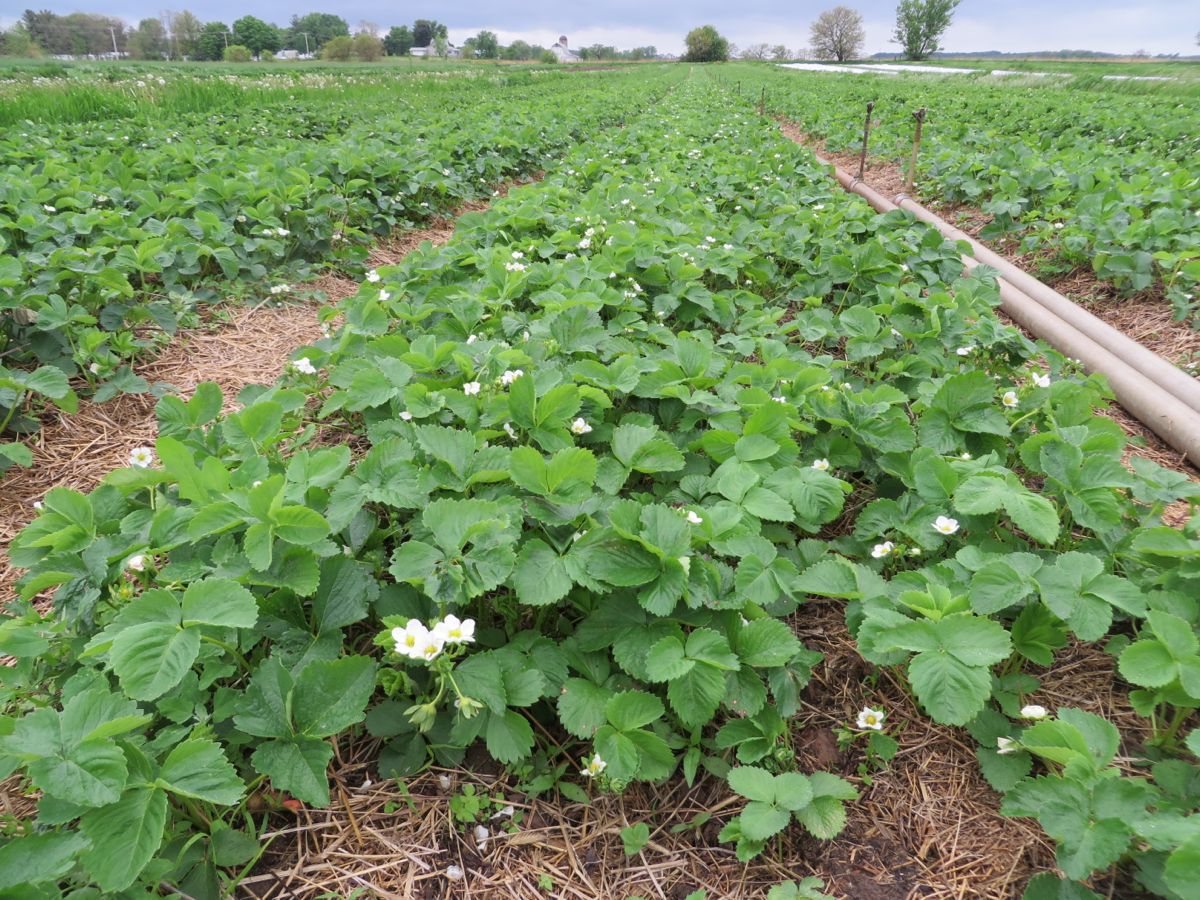
The strawberries are blossoming heavily and the berry field looks great. We expect to host strawberry u-picks for members during the last two weekends of June. Watch our emails for the dates, times and other information about the u-picks. Berry price will probably be the same as last year, $2.20/lb. Notice the irrigation pipe? We keep it in the field, just in case we need to irrigate to protect the blossoms and berries from frost. Steve has irrigated three nights so far this spring. We can’t take a risk with such a valuable (and treasured) crop.
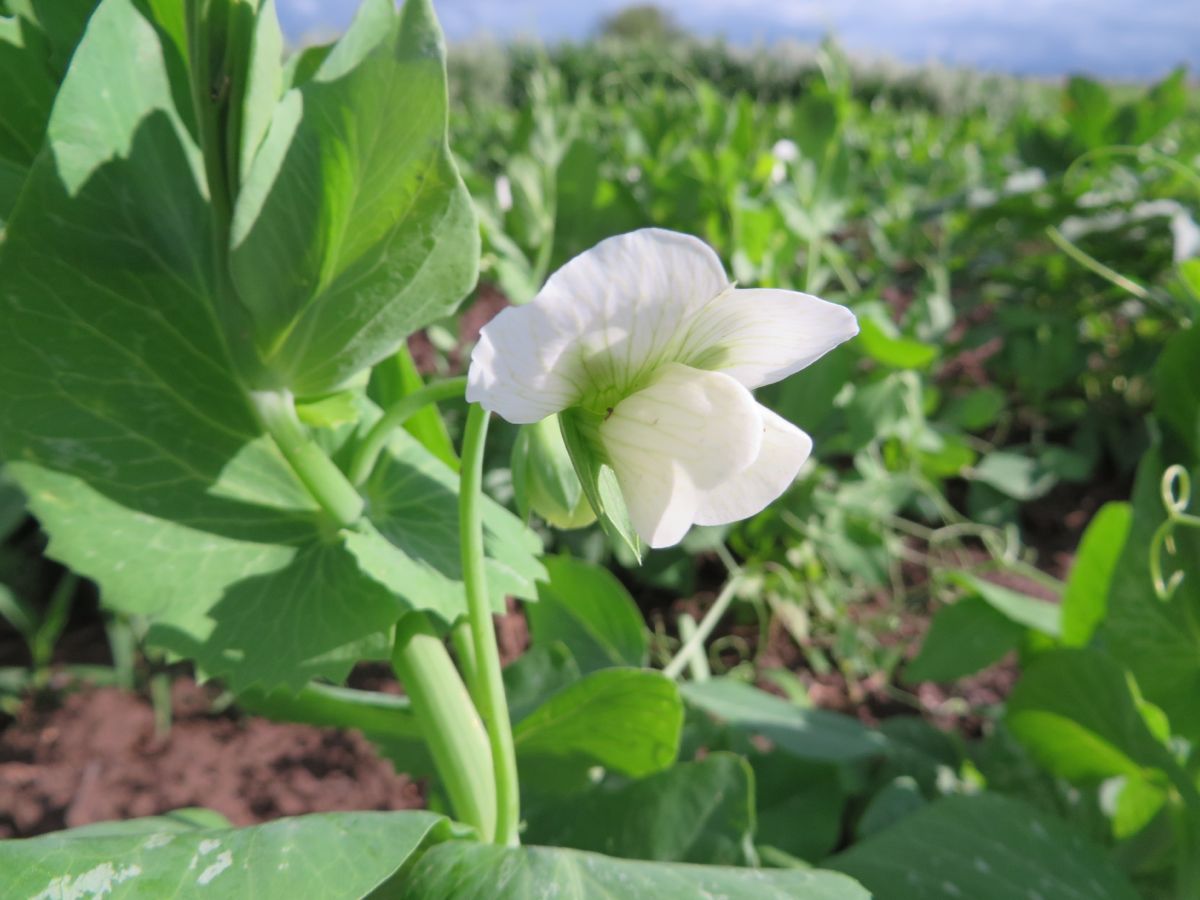
The peas have just begun blossoming. Best guess = there will be peas in the CSA boxes in three weeks. We don’t know if sugar snap peas or snow peas will be ready first. It’s a race.
Veggie List and Veggie Notes (5/28/15, week #2, green EOW)
We offer information the first week we pack a vegetable. Read last week’s newsletter for storage and cooking information for asparagus, rhubarb, and green garlic.
Asparagus, 1.3 lb
Bok choy, 1
Rhubarb, 1.5 lb
Red bibb lettuce
Spinach, 1 bunch
White salad turnips, 1 bunch
Parsnips, 1.75 to 2 lb
Green garlic, 1 bunch
Next week’s box will probably contain asparagus, lettuce, white salad turnips, scallions, some kind of spring green, and more. We might have spinach for you again next week.
Bok choy (large rosette with thick white stems and green leaves) – This Asian green is good for stir-frying or sautéing or in soup. You can think of the stems and leaves as two separate vegetables. The stems require longer cooking. The leaves will cook almost as quickly as spinach. Bok choy stores well, so feel free to pull off leaves as you need them, or use the whole head at once. Refrigerate in a plastic bag.
White salad turnips (bunched white roots with green tops) – I know that returning members look forward to these sweet and delicious turnips, which taste nothing like the turnips that are harvested in fall.
– Storage: Cover and refrigerate.
– Uses: Both the turnip roots and tops are edible. Slice the sweet roots and add to salads. They can be cooked and are especially good when lightly sauteed in butter. Stir as little as possible so they brown on at least one side. The turnips greens are excellent cooked. Treat them like mustard greens.
– Our favorite use: Slice the roots very thinly and combine with a mixture of rice vinegar, mirin, soy sauce, sesame oil. Eat immediately or marinate.
Parsnips (long white roots) – We had a bumper crop of parsnips last fall, so we left some in the ground for spring harvest. Parsnips are one of the few annual crops that we can overwinter in the field. Those long, white roots are not carrots, they are parsnips. The two vegetables are related. Unlike carrots, parsnips are rarely eaten raw. When cooked, parsnips are sweet and starchy. Brown them so the sugars caramelize, to give the best flavor. Here are our favorite ways to prepare parsnips:
– Parsnip fries are delicious: cut like French fries, coat very lightly with oil, place on a cookie sheet and roast in a hot oven until cooked through and browned.
– Substitute grated parsnips in a potato pancake recipe. They brown beautifully and are very tasty.
– We often pan-fry parsnips with onions and garlic.
THIS WEEK’S RECIPES
Comforting Classics
Rhubarb Cream Cheese Bars
Spinach and Almond Salad with Orange Honey Vinaigrette
Pureed Asparagus and Parsnip Soup
Bok Choy with Garlic
Steamed Parsnips with Maple Butter
Salad Turnip Pickle
Outside the Box Recipes
Star Anise Baked Rhubarb
Almost No Work Baked Spinach and Asparagus Risotto
Broth Infused Asparagus
Orecchiette with Spinach, Bok Choy and Ricotta
Parsnip Tart
Harissa Spiced Salad Turnip Salad
Kitchen Sink Recipe
This is a recipe that is very flexible — you can add just about many of the veggies from the box.
Quick and Easy Dinner Recipe
Let’s start!
- On: May 20, 2015
 0
0
Welcome to our CSA! It’s time to eat fresh food again. Our CSA deliveries begin this week for weekly members and for purple every-other-week (EOW) members. Green EOW, your first delivery is next week, May 28/29 (Thursday/Friday sites).
Things you need to know.
♦ On Thursday, we deliver to Evansville, Fitchburg, Madison, McFarland, Middleton and Oregon.
♦ On Friday, we deliver to Brookfield, Janesville, Mequon, Milwaukee and Wauwatosa.
♦ We post this newsletter/blog each Wednesday night, with the list of veggies for the week, quantities, information about storage and preparation, news of the farm, and a recipe list. We will send an email on Wednesday night to alert you once the newsletter is ready to read.
♦ Want earlier notice of what will be in the box? Check our website sidebar around 7 p.m. on Wednesday night. I’ll post the list under “Box Contents.” I also provide a tentative list for the following week in the Veggie List section of this newsletter. The list is not complete but the items listed are ones we feel confident about.
♦ EOW and weekly members, we assume you read all the newsletters, even on your “off” weeks. This newsletter (and our emails to you) are our means to communicate with you.
♦ We have a new system for rescheduling vacation boxes. Please read the section below.
♦ The first few boxes of the season are always the lightest. EOW members, do not worry that you have signed up for the wrong share. Our deliveries get heavier and more abundant as the season progresses.
New system to reschedule vacation boxes.
Each membership can reschedule up to two vacation boxes per season. Please use our new online system. It promises to be a big time-saver for us. Please do not email us to reschedule boxes unless you have trouble with the online system. Here are the basics:
♦ Follow this link to cancel or reschedule a box. The language is a bit odd, but the system works smoothly if you follow our instructions.
♦ The final deadline to cancel or reschedule is 11:59 pm the Sunday night before your delivery. After that, the system shuts down for the upcoming week. In the past, we asked for one week’s advance notice. The new system allows you to reschedule as late as the Sunday before your delivery. We think that will be helpful. However, we will not be able to accommodate late requests after Sunday night. Please don’t ask.
♦ For easy access, we will include the rescheduling link in the signature of our Wednesday night email each week.
♦ Weekly members, you will receive two boxes on the week that you schedule your replacement box. EOW members, you probably want to plan your replacement box for a week when you are not already scheduled to get a box. In that case, you will get one box on the week of your replacement box.
Farm News
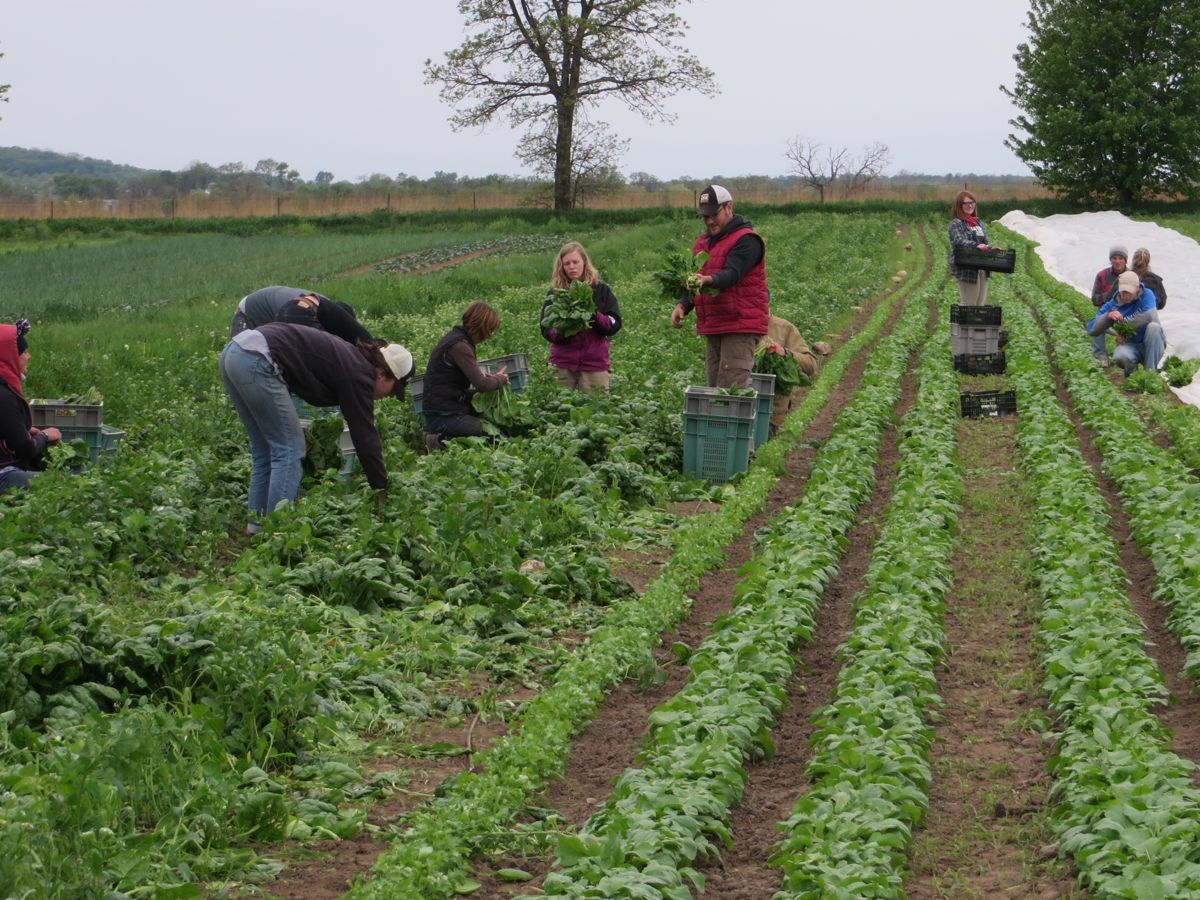
At this time of year, we spend most of our time planting and weeding. It was great to begin harvesting too. Our crew gathered in one field today to harvest spinach (at left) and arugula (at right). In between are cilantro, radishes, and salad turnips for upcoming boxes. The white row cover on the right protects our earliest planting of white salad turnips. We will harvest those for you next week.
Veggie List and Veggie Notes (May 21/22, week #1, purple EOW)
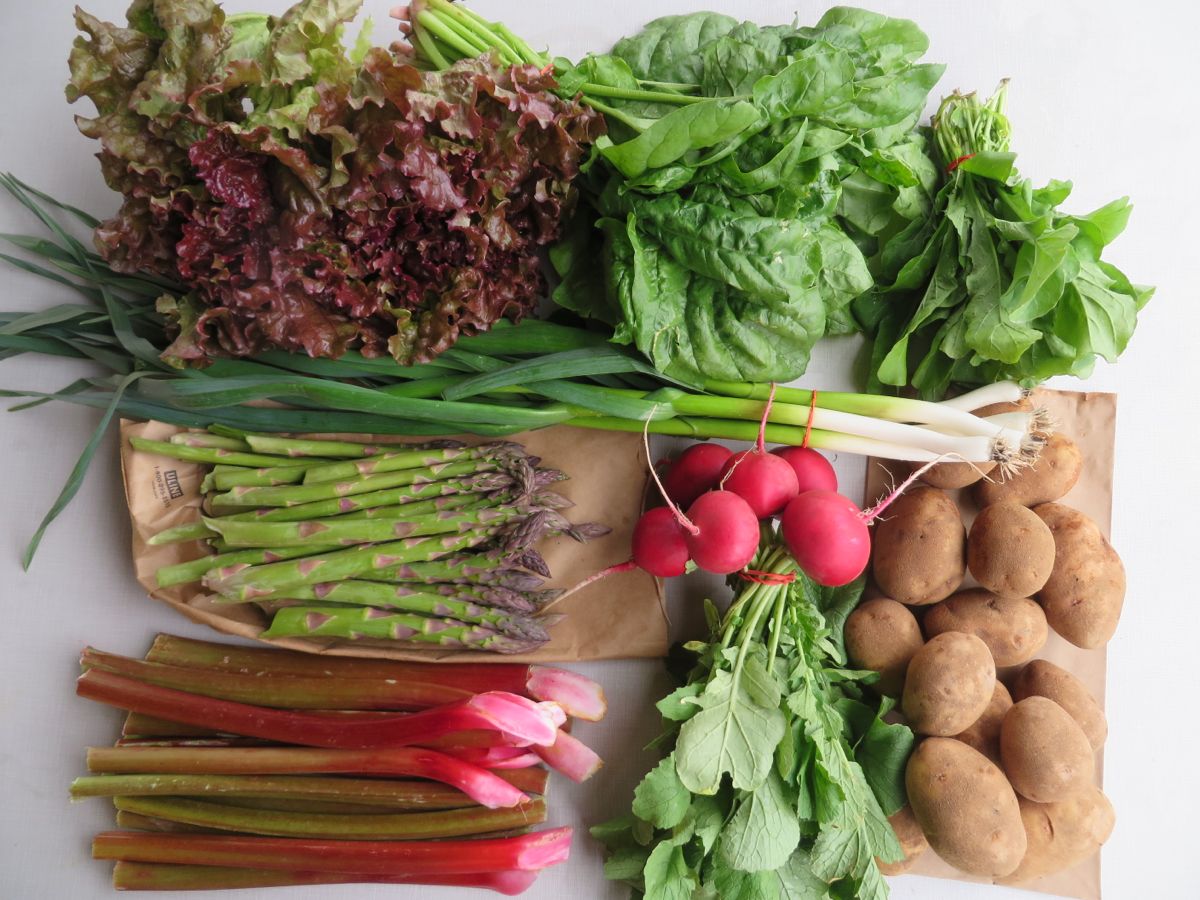
How’s that for a pretty first box? Clockwise from top right, arugula, potatoes, radishes, rhubarb, asparagus, red leaf lettuce and spinach. Green garlic in the center.
Read this section each week for specific information about the produce. For example, see our notes below about how to store your potatoes.
Asparagus, 1.5 lb
Rhubarb, 2 lb
Red leaf lettuce
Spinach, 1 big bunch, about 1.25 lb.
Arugula, 1 tender bunch
Radishes, 1 bunch
Goldrush potatoes, 3.5 lb
Green garlic, 1 bunch
Next week’s box will probably contain asparagus, rhubarb, lettuce, spinach, bok choy, white salad turnips, parsnips, and green garlic. Watch next week’s newsletter for the final list.
Asparagus – Enjoy this spring treat! Your asparagus will be green or purple. The purple variety turns dark green when cooked. Its flavor is almost identical to normal green asparagus. Wash your asparagus thoroughly to remove hidden grit. Submerge in water, soak briefly, then swish vigorously and pull out of the water with the tips pointing down. The draining action helps pull the grit out of the asparagus tips. Repeat several times.
Storage: Asparagus is perishable, so eat it as soon as possible. Store it in the paper bag we packed it in, and wrap loosely in a plastic bag. The paper bag protects the asparagus tips from direct contact with the plastic bag. The plastic bag keeps the asparagus from wilting.
Preparation: We snap our asparagus at harvest, rather than cutting. Therefore, there is no need to snap the stalks to remove fibrous ends. For the same reason, it is not necessary to peel the asparagus stalks. It’s OK to trim the end a bit.
Cooking: If your asparagus stalks vary greatly in size, you will want to cook the thicker ones longer. Put the asparagus in a steamer pot over water. Alternatively, you can lay spears flat in the bottom of a broad pan, with ½ inch of water. Cover and steam over medium heat until just tender. Use two forks or a spatula to turn the asparagus during cooking, rotating the bottom spears to the top. Drain and serve. Also excellent broiled or grilled. Good dressed with vinaigrette, or simply with lime juice, salt and pepper.
Rhubarb – Refrigerate in a plastic bag. FYI, 2 lb of rhubarb yields 6 – 6.5 cups when chopped.
Stewed rhubarb: This is the simplest way to prepare rhubarb. Chop rhubarb into one inch chunks. Stir over medium heat with a small amount of water in the bottom of the pan. The rhubarb will release moisture as it cooks. Stew until it softens and falls apart. Sweeten to taste with honey or sugar. Eat warm on its own, over vanilla ice cream, on pancakes, etc.
Spinach and lettuce – Wash your greens to remove grit splashed into the heads by rain. Cut to the size you like, submerge in water, swish gently, then pull from the water and drain in a colander. Some weeks, you will need to repeat in fresh water.
Storage hint – To extend the storage life of your tender greens, wash them, dry in a salad spinner, then store in a dry container or bag. Lettuce and spinach last much longer when handled this way.
Arugula – (small bunch of green leaves with pungent scent) – Arugula is good mixed with lettuce or spinach in salads, or added to cooked dishes such as lasagne or quiche. I love it on sandwiches. This arugula is thin-leaved and tender and will not store for long. Eat soon. Cover and refrigerate. There is some minor wind damage at the tips. If you’ve been outside this past week, then you know how that happened.
Goldrush russet potatoes – Please refrigerate these potatoes. They are in great shape now but will sprout within days if stored at room temperature. They’ve been stored all winter and want to grow. Store in a paper bag to protect from light, even in the fridge. We grow everything we send in our CSA boxes except potatoes, garlic and mushrooms, which we buy from organic growers that we trust. We purchased these potatoes from Jesse Perkins at Vermont Valley Farm. Jesse says the potatoes have a higher sugar content because of starch to sugar conversion during cold storage. The potatoes taste a bit sweet, and will blacken slightly when fried. It’s a harmless color change due to the sugar conversion.
Green garlic (looks like scallions, tastes like garlic) – Last fall, we planted garlic cloves that grew into the stalks we harvested this week. If left to grow until mid-summer, the slim white bulb on this week’s garlic would divide and form the usual cluster of cloves in a garlic bulb. Green garlic is more pungent than scallions, so slice thinly and use sparingly when raw. It mellows when cooked. Chop and add to any cooked dish that would benefit from garlic. Use the white bulbs and pale green stems. Avoid the dark green stems and leaves, as these are fibrous.
Comforting Classic Recipes, from chef Pat Mulvey at Local Thyme
Grilled Asparagus with Lemon Garlic Butter
Spinach and Radish Green Frittata
Arugula Salad with Blue Cheese and Nuts
Outside the Box Recipes
Asparagus Cashew Salad in Lettuce Cups
Meatballs Packed with Arugula Pesto OR Lentil “meat” balls with Arugula Pesto
Kitchen Sink Recipe
Pat’s weekly ‘kitchen sink recipe’ will be very flexible — you can add almost any of the veggies in your box. If this week’s soup gets “too crowded” for all the veggies you want to pack in, add more stock/seasonings.
Longevity Kitchen Soup with Shrimp or Tofu, Spinach, Radish and Shiitake
Quick and Easy Dinner Recipes
Spring update
- On: April 15, 2015
 0
0
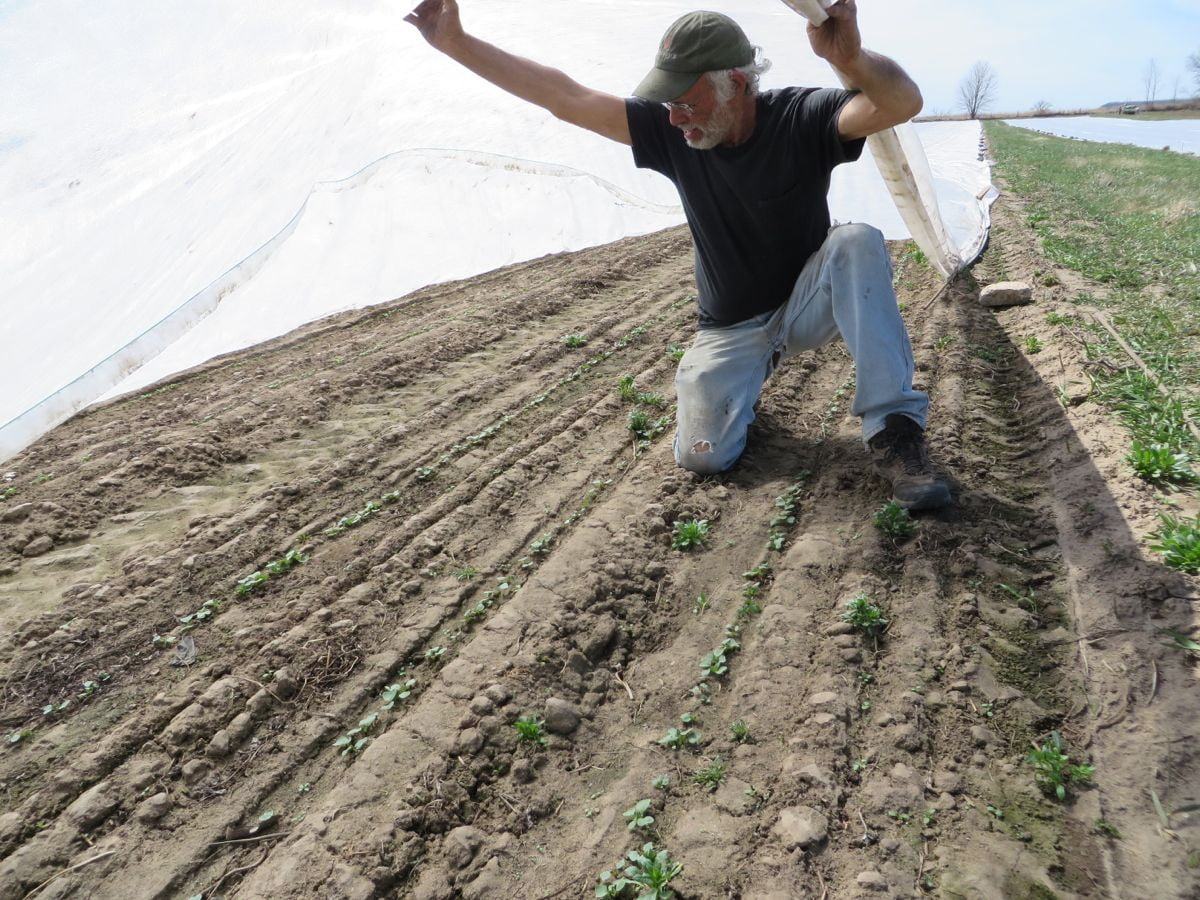
We gambled and planted our first seeds outside on March 15, before the big snow. Steve didn’t mention this to our farmer friends right away. Planting that early is risky. What if it was a flop? Tucked under white floating row cover, the spinach, radishes, salad turnips and greens are doing great. If there’s a chance to get in the fields early, we’ll take it. Steve crawls under the row cover every few days to check on the seedlings.
It’s time to register for your CSA share, if you haven’t already. Returning Tipi members, go here to re-enroll. New members can register here.
Today was a remarkably productive day. We’re flying through our spring tasks. Let’s share some photos.
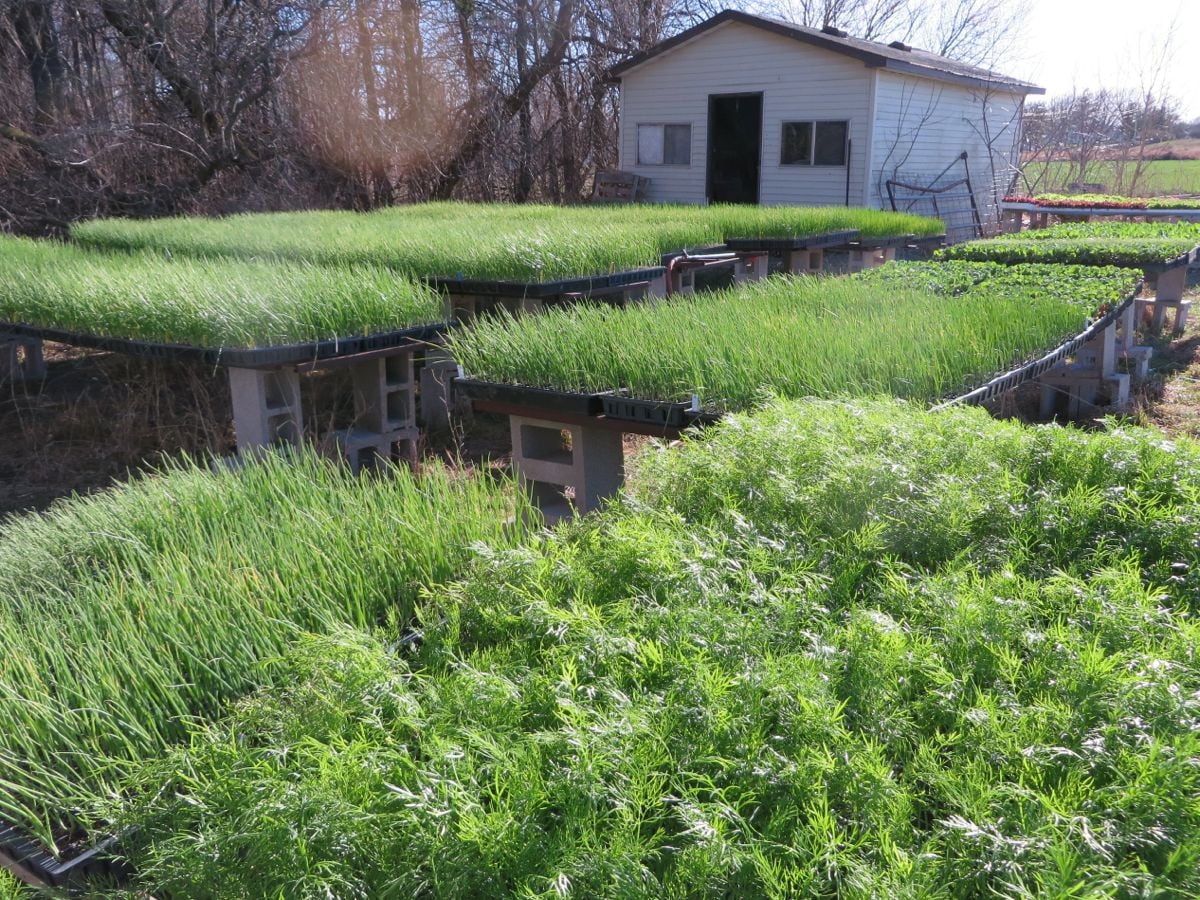
All the seedlings are so strong right now. The onions are beautiful as they wave in the wind. We will start transplanting these into the field tomorrow. This photo represents spring hope for us; the promise of the young seedlings and the bright green cover crops in the field behind the shed.
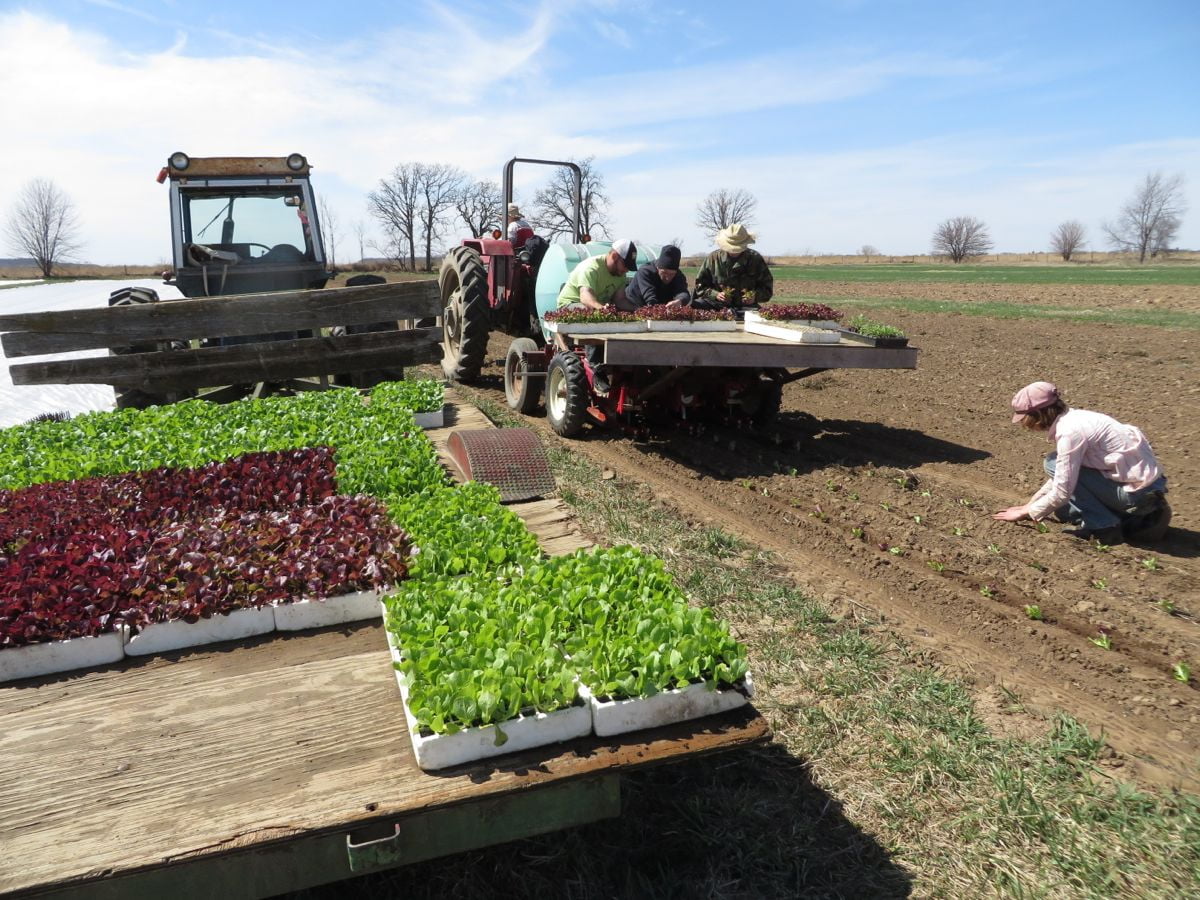
We transplanted our first lettuce on April 1. No fooling. It’s growing well under heat-gathering row cover. Lettuce #2 went into the ground today. Simone drives the tractor while Joel, Dan and Jon ride the transplanter and Kerry checks the seedling depth.
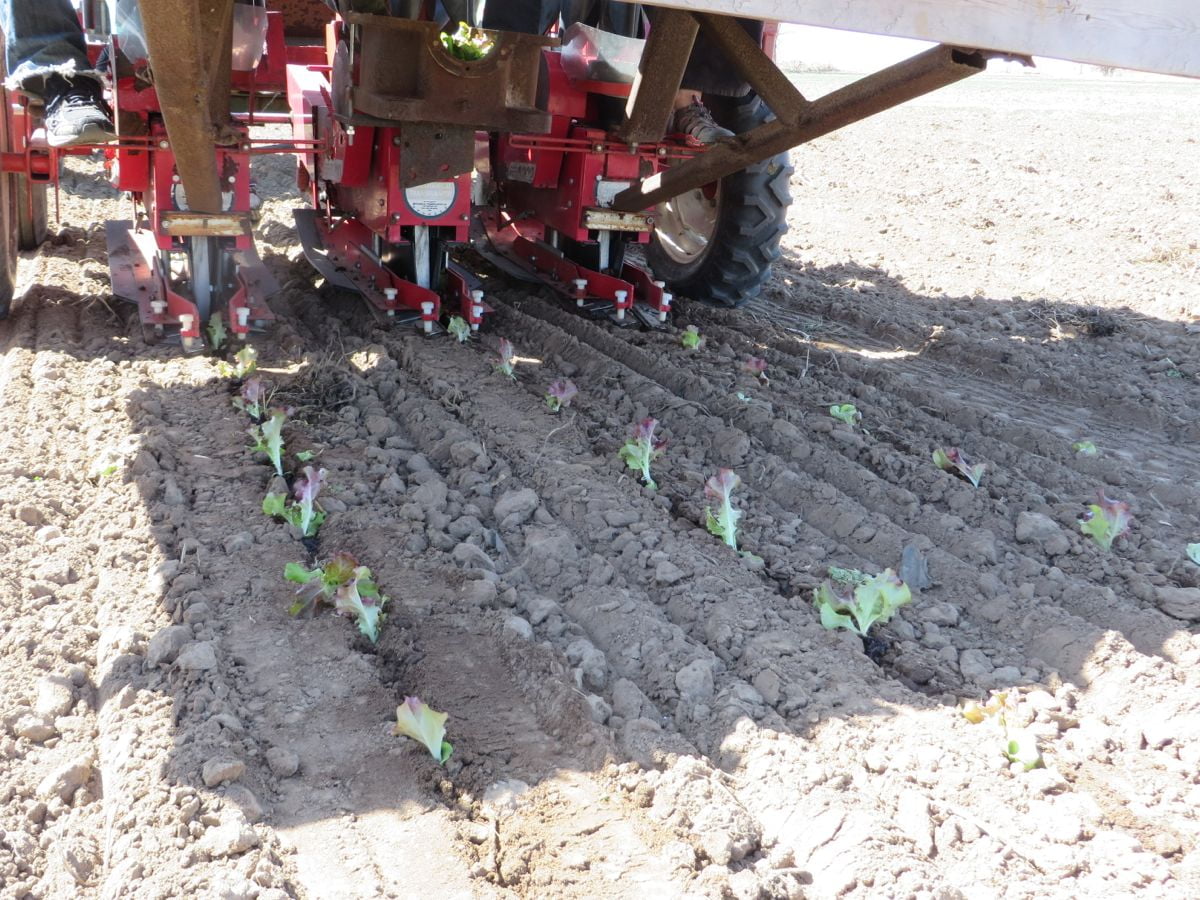
We love our mechanical transplanter – it saves so much effort versus transplanting by hand.
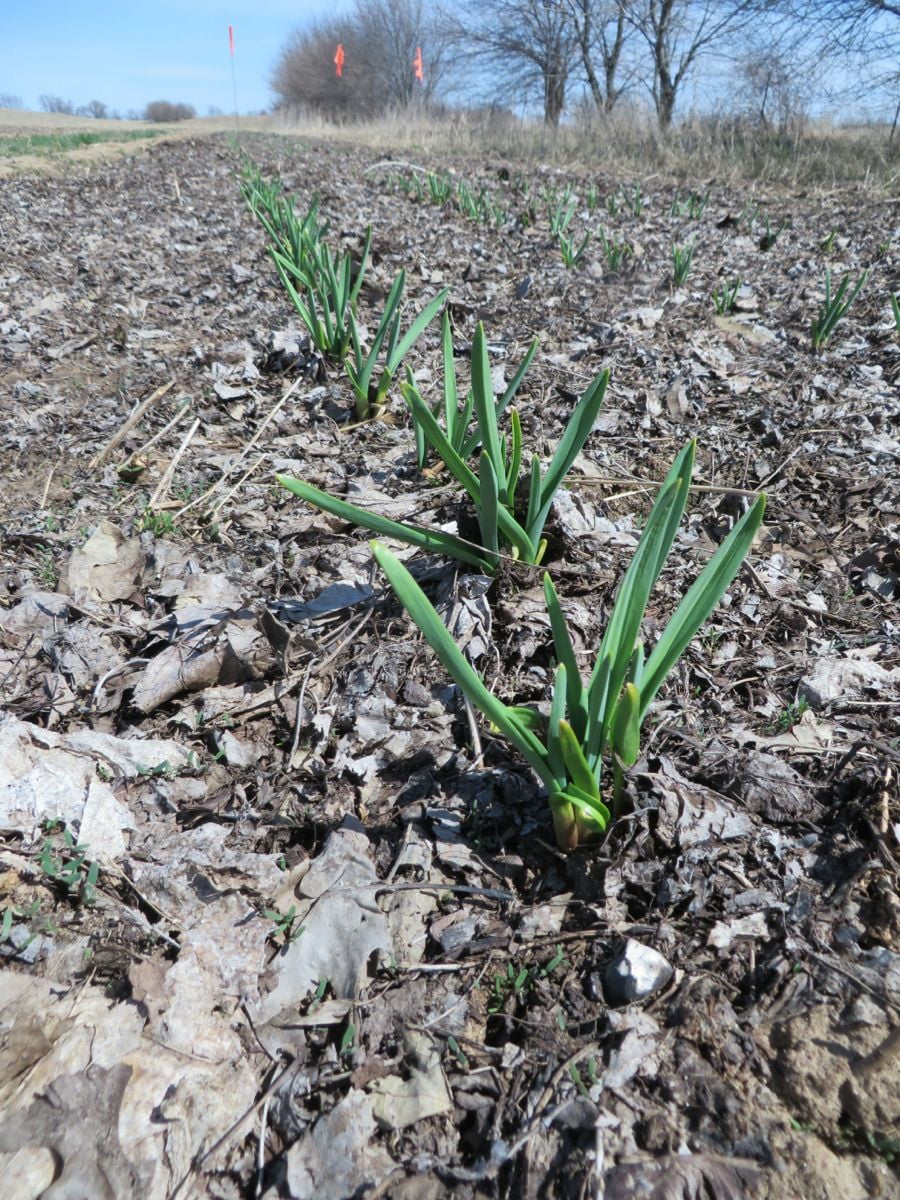
The green garlic survived the winter without trouble.
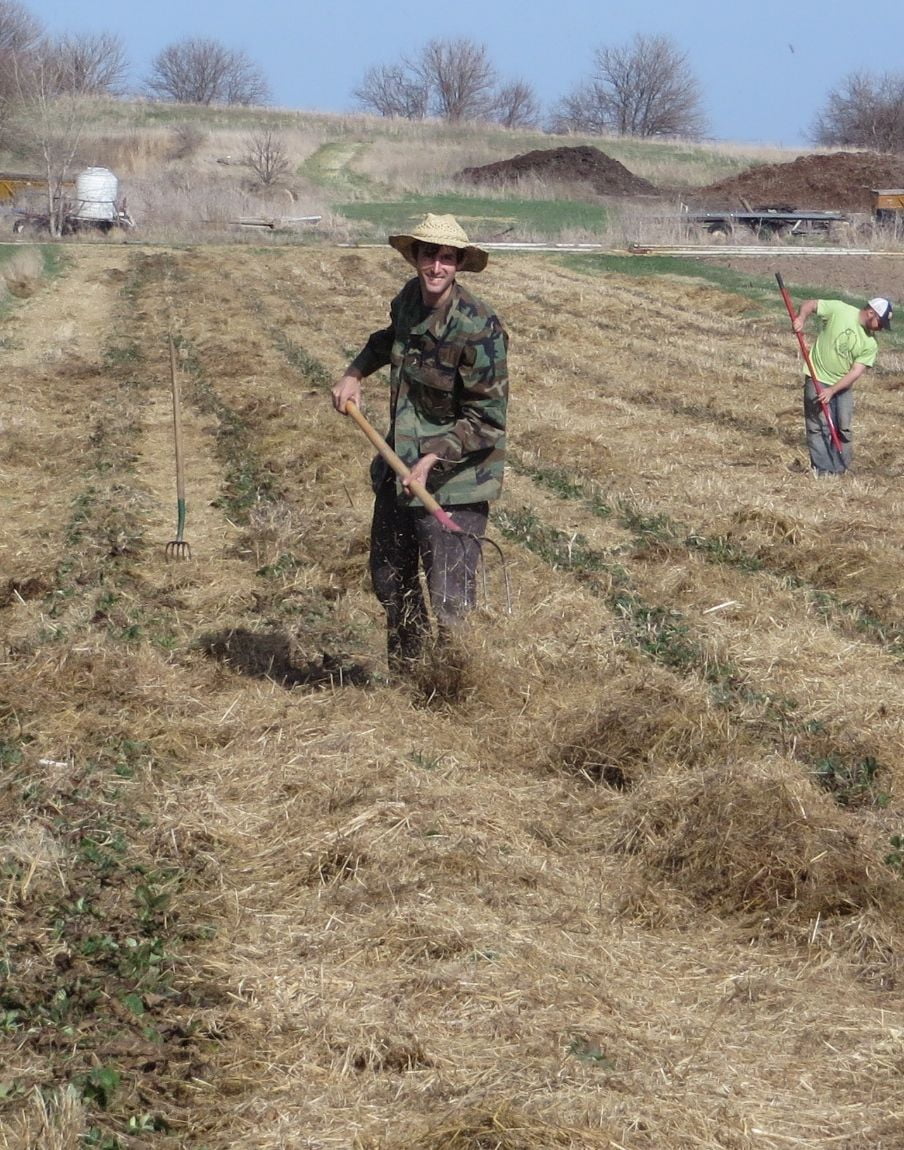
Jon and Joel pull mulch off the strawberry plants so they can start to grow.
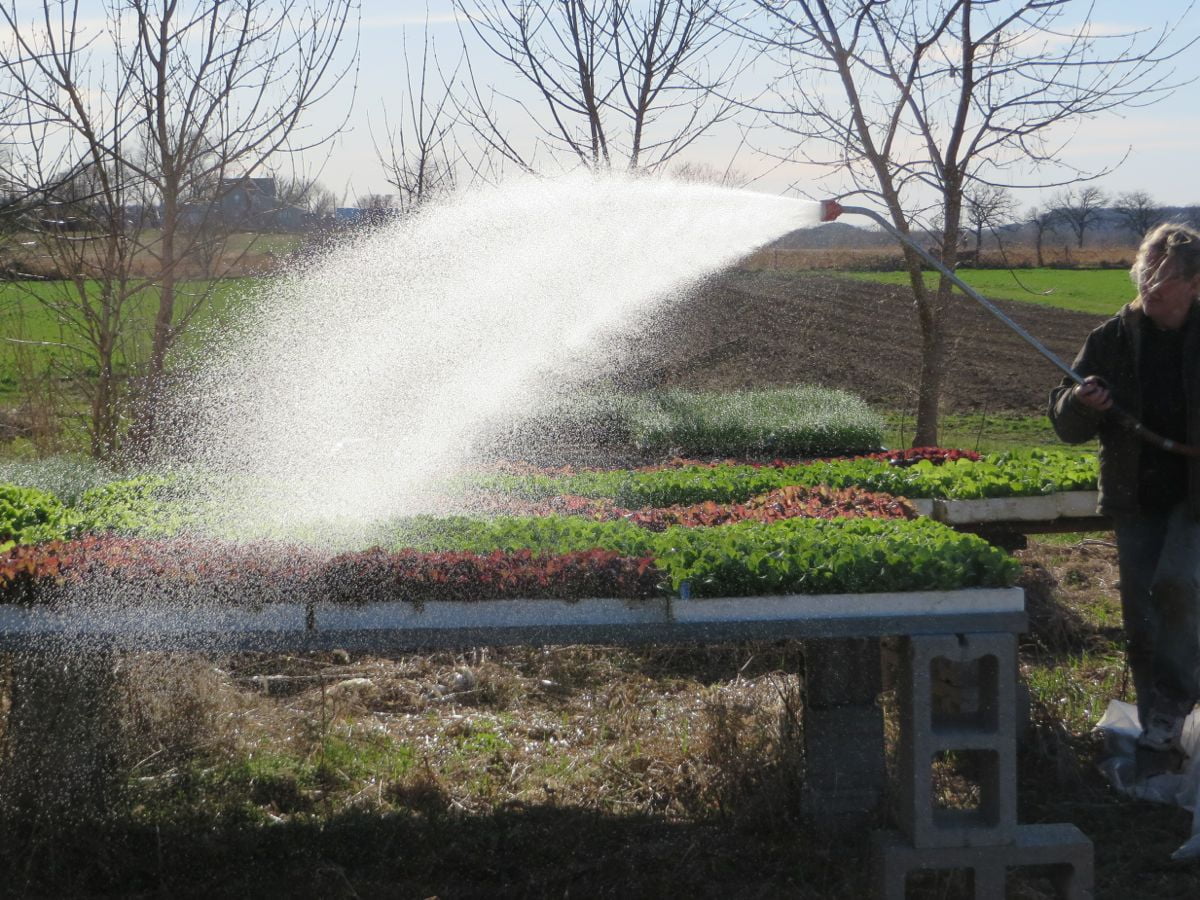
Simone waters lettuce seedlings in flats. The light is gorgeous at the end of the day.
Planting day
- On: March 03, 2015
 0
0
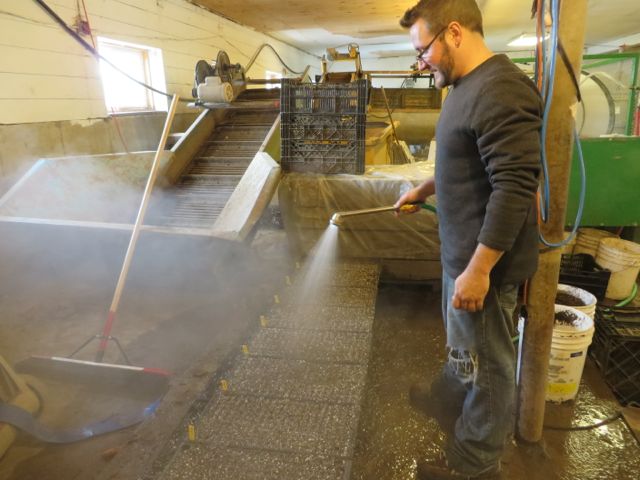
Our 2015 farming season began yesterday. We seeded our first flats of onions and lettuce, and should be working in the fields in just five or six weeks. That feels crazy, doesn’t it? It’s tight quarters inside the barn. We tuck the seeding work amongst our root-washing machinery. We have enough stored carrots and celeriac for one more month of sales. By then, we’ll be fully engaged with the new season and ready to be done with carrots for a while.
Time to sign up for CSA
Start looking forward to another vibrant season of local produce.
Returning Tipi CSA members, you can re-enroll here: tipiproduce.csasignup.com/members/returning
New CSA members can enroll here: tipiproduce.csasignup.com/members/types
Refer a friend. Tipi members, refer a friend to our CSA, and we’ll give you a $20 discount on your share. Just ask your friend to mention your name when they register for their CSA share. One discount per new membership.
New CSA site in Fitchburg

We’ve added a new CSA pick-up site in Fitchburg, at 3050 Cahill Main. Pickup hours are Thursdays, 1 – 7 pm. Longterm Tipi members Laura Rozumalski and Tyler Kapta have offered to host a site at their new Chimmies sandwich shop. They are excited to run their own business. The location is close to Fish Hatchery Road. If you have already signed up at another site but want to move to the new site, just let us know.
Here are the other new sites we’ve added in the past year:
Madison/N. Marquette Street, Thurs 4:00 – 7:00 pm, at 102 North Marquette Street, Madison
McFarland, Thurs 4:30 – 7:00 pm, at 5216 Rustling Oaks Lane, McFarland.
Mequon, Friday 1:00 – 8:45 pm, 7590 W. Mequon Road, Mequon, at Outpost Natural Foods
Fresh, farm-raised electricity!
After a year of deliberations, we have a new photovoltaic solar array generating electricity on our farm. The system has been up and running for one week. The guys from H&H Solar faced intense cold weather while constructing the array but they got the job done. It took about a month to complete, including all the wiring. In winter, the array will produce all the electricity we need. In summer, it will produce about half the electricity the farm consumes. Our usage goes up in summer when the coolers and irrigation well are running. We estimate that the array will save burning 30,000 lb of coal each year. This is a big step toward reducing our carbon footprint.
Improvements at Local Thyme
Pat Mulvey of Local Thyme will provide tasty recipes for us again this year. We read your surveys last fall and have made two substantial changes in response.
♦ First, you commented that logging into the Local Thyme website was burdensome. This year, we will link directly to the weekly recipes from my Wednesday night email. We will still have Local Thyme memberships to navigate her recipe database, but we will be able to access the weekly recipes without logging in. That should make things easier.
♦ Pat has redesigned her service this year to provide more recipes to suit a wider range of cooking styles. Many members loved Pat’s recipes. However, for members who did not use the recipes, feelings were split between “I prefer very simple meals” to “Give me recipes for unusual ethnic dishes.” We are a diverse crowd! Each week, we will give Pat a list of four to six vegetables from the CSA box. She will craft an easy ‘comfort food’ recipe and a ‘challenging’ recipe for each vegetable, backed with vegetarian and gluten-free options, plus easy recipes for quick weeknight meals.
We are support the direction Pat is taking her small business. It is a change from the menus she’s prepared for us in the past, but we think everyone will appreciate her efforts to serve a wider range of home cooks. To wrap up, let me quote a few members who enjoyed the Local Thyme menus.
“Local Thyme was a big deciding factor for us to go with this CSA. We’ve been CSA members in another city in the past; we knew what to do with a lot of the produce, but sometimes you run out of ideas. We didn’t use Local Thyme every week, but we used it enough to either use the recipes or be inspired to try something new. It was a fantastic resource.”
“This service definitely helped our family utilize everything in our box. Since you began offering this as a perk of the membership, we have been able to have far more home-cooked meals and far less waste. We love it!”
Our goal is to make our CSA boxes easy to eat. The Local Thyme recipes can help.
Storage share (Nov. 20/21, 2014)
- On: November 19, 2014
 0
0
Things you need to know about your winter share
* Your delivery will consist of two different boxes, labeled “A” and “B”. Take one “A” box and one “B” box. The boxes contain different vegetables.
* Please pick up your boxes on the day of delivery, during the normal hours for your site. Don’t count on picking up late or the next day. It will be very cold during the deliveries and the produce will freeze overnight at the unheated sites.
* Outpost members, please get your boxes on Friday. Do not ask the Outpost staff to hold your boxes until Saturday; this is their busiest weekend of the year.
* Members at outdoor sites, please carefully put the blankets back on the boxes. That keeps everyone’s produce in good shape.
Veggie List and Storage Info (Storage share, 11/20 and 11/21/14)
We hope you enjoy this shipment of veggies! Strategize to use them well, as some will last longer than others.
* These vegetables are the most perishable: fennel, kale.
* These are the next-most perishable: Brussels sprouts, cabbage, leeks and onions. Keep an eye on your butternut, potatoes and sweet potatoes. The last two are susceptible to drying out.
* These will last the longest: Beauty Heart radish, beets, carrots, celeriac, garlic, parsnips and rutabaga.
Box “A”
Beauty Heart winter radish, 1.5 lb
Beets, 3 lb
Brussels sprouts, 1.1 lb
Carrots, 6 lb mixed colors
(orange 4 lb, yellow 1 lb, purple 1 lb)
Celeriac
Fennel, 1
Kale, 1 bunch
Leeks, 3 lb
Parsnips, 3 lb
Rutabaga, 1.5 lb
Savoy cabbage
Box “B”
Butternut squashes, 12 – 13 lb
Sweet potatoes, 7 lb
Russet potatoes (or mixed russets & reds), 5 lb
Yellow potatoes, 5 lb
Onions, 5 lb
Garlic, 4
Beauty Heart radishes (round, white with pale green shoulders and bright pink interior) – Refrigerate. The interior color is lovely. Slice thinly and add to salads, cook lightly in mixed vegetable medleys or cut into matchsticks and add to pasta salads. We enjoy grated carrot and Beauty Heart salads all winter.
Beets – Refrigerate in a plastic bag. Beets will store for two months or longer.
Brussels sprouts – Refrigerate in a plastic bag. Eat soon.
Cabbage – Refrigerate. Cut off chunks as needed.
Carrots, orange. Refrigerate in a plastic bag. Will keep for several weeks.
Carrots, yellow and purple. These varieties are pretty AND they taste good. The purple carrots will turn your tongue green. That will get the kids interested.
Celeriac – Will store for months in your fridge. Cut off chunks as needed.
Garlic. Can be stored at room temperature.
Leeks. Refrigerate and eat within three weeks. Leeks are not a long-storage crop. You may need to strip off one or two outer leaves to freshen the leeks before you cook them.
Onions: Store in a cool, dark spot or refrigerate. Protect from light. Exposure to light stimulates sprouting. Refrigerate if you expect to hold for more than one month.
Parsnips (These look like rough white carrots.) – Refrigerate in a plastic bag. Parsnips will store for two months but will darken in color.
Potatoes: Can be stored at room temperature or in a cool spot, but must be kept in the dark so they do not turn green. They will store longer if kept cool. Around 40 – 50 F is ideal. I find these potatoes from Chad Malek are unusually thin-skinned. This is great for cooking, but means they lose moisture quickly. Keep them in the paper bag, then cover the bag with a cloth or a loose plastic bag to their moisture loss.
Rutabaga (round root, cream-colored with purple shoulders) – Cover and refrigerate. Will store for several months.
Sweet potatoes – These are the Covington variety, and have developed excellent flavor and sweetness. Store at room temperature, no lower than 55 F. Keep them on your kitchen counter where it’s easy to keep an eye on them. Cook promptly if they start to soften. The roots come in a wide ranges of sizes and all are good.
Winter squash – You will receive three to six squash, depending on size. They are a mix of varieties: Metro, Waltham, JWS. Store winter squash in a cool, dry place. 50 F is ideal. Do not put in a plastic bag. Inspect your squash frequently and cook promptly if you see any soft spots developing. You can cook, mash and freeze the squash for future use. I find that you can refrigerate cut raw squash for up to one week. This runs counter to the accepted way to store squash, but is useful if you want to cook just half a squash at one time. Try microwaving your squash for one to two minutes before cutting or peeling. This softens the squash and makes large butternuts easier to handle.
What are you cooking for Thanksgiving?
We are creatures of habit when it comes to Thanksgiving. Here are our plans so far: brined roast heritage turkey from Matt Smith at Blue Valley Gardens (Beth), Brussels sprouts with garlic-mustard vinaigrette (Steve), roasted sweet potatoes with garlicky yogurt dip (see below, Sophie), glazed butternut squash (Beth), crunchy carrot-Beauty Heart salad with sesame-seed dressing (Steve), homemade applesauce (Ari), cranberry sauce (friends), and apple pie (Sophie). I’d like to add a raw kale salad, if I can get our neighbor to give us her recipe. We love celebrating Thanksgiving and the end of harvest season!
Menu Ideas
There are so many great Thanksgiving recipes and menus online right now. Many include veggies that you will receive in this delivery. Here is a list of the recipe sites I rely on. Each site has lots of recipes which feature vegetables. Search any of these sites if you are stumped about what to do with your storage veggies.
* I enjoy the Food52.com site. They have posted an entire section on Thanksgiving, including 13 dishes for feeding vegetarians on Thanksgiving. I look forward to trying their recipe for Variegated Spiced Latkes, which combines potatoes, parsnips and sweet potatoes.
* The New York Times as a brand-new iPad app called Cooking. It is good! They post appealing recipes and recipe collections every day. For example, we recently made Spicy Pan-Fried Noodles with the last of our scallions and peppers and it was excellent. In my opinion, Melissa Clark is the best NYT food writer. She’s practical and her dishes are always flavorful. Mark Bittman and Martha Rose Shulman are other favorites. The app and recipes appear to be free to the public, but I think you need to be a NYT subscriber to save recipes.
* Smitten Kitchen has posted new Pinterest boards for both Thanksgiving, Savory and Thanksgiving, Sweet.
* The Kitchn. I found this site after wandering over from their Apartment therapy home-design site. Good recipes.
* 101cookbooks. Always has good vegetarian recipes. The author has not posted this year’s collection of Thanksgiving recipes yet but I keep checking!
* Finally, remember that we have access to the entire catalog of Local Thyme recipes all winter. Check them out for Thanksgiving ideas.
Garlicky Yogurt Dip
This dip is great with everything. We enjoy it with roasted sweet potatoes or winter squash, raw carrot sticks, or lamb meatballs. When short on time, I make the basic dip, but it is especially nice with any fresh herb. I’ve prepared this with several olive oils but like it best with Spectrum organic extra virgin olive oil because it is fragrant and not bitter.
Basic ingredients:
1 medium clove garlic
2 Tbsp. olive oil
1 cup plain nonfat Greek yogurt
1/8 tsp salt
1/4 tsp paprika
Optional additions:
Lemon juice
Any finely-minced herb: parsley, cilantro, mint. Start with 1 tsp.
Finely minced chives OR 1 small scallion, finely minced
1. Grate the garlic clove into a bowl or a wide-mouthed pint jar. Add the olive oil. Stir and let sit for 5 minutes for the garlic to diffuse into the oil.
2. Mix in the yogurt, 1/4 cup at a time. Stir vigorously. Taste after you’ve added 1/2 cup, so you can recognize how well the yogurt and olive oil taste together.
3. Add the salt, paprika and any optional additions and stir well.
4. Evaluate the flavor. Add more olive oil and/or salt if the flavor is not ‘umami’ enough.

